Paul van Yperen's Blog, page 273
May 1, 2018
Othello (1922)
The German silent film Othello (Dimitri Buchowetzki, 1922) is based on William Shakespeare's classic stage play of jealousy and deceit. Werner Krauss plays the treacherous Iago, who plans to ruin the life of Othello (Emil Jannings) by provoking him to jealousy.
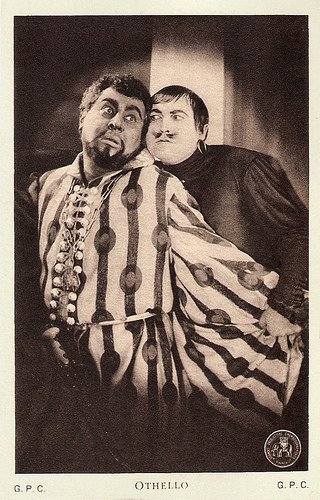
French postcard by Edition de la Cinématographie-Française, Paris. Photo: G.P.C. Publicity still for Othello (Dimitri Buchowetzki, 1922) with Emil Jannings and Werner Krauss .

French postcard by Edition de la Cinematographie Française. Photo: Grandes Productions Cinématographiques (G.P.C.). Photo: publicity still for Othello (Dimitri Buchowetzki, 1922).
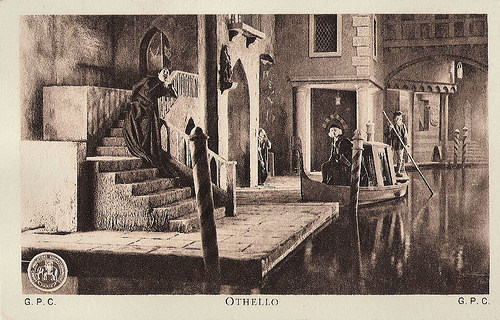
French postcard by Edition de la Cinematographie Française. Photo: Grandes Productions Cinématographiques (G.P.C.). Photo: publicity still for Othello (Dimitri Buchowetzki, 1922).
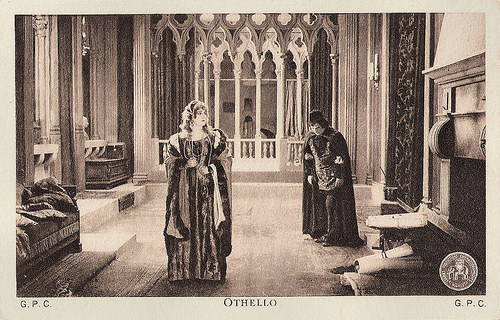
French postcard by Edition de la Cinematographie Française. Photo: Grandes Productions Cinématographiques (G.P.C.). Photo: publicity still for Othello (Dimitri Buchowetzki, 1922) with Theodor Loos and Ica von Lenkeffy.
Bitter jealousy
As Venice welcomes their victorious general, Othello the Moor ( Emil Jannings ), back to the city, some of them are waiting for Othello to choose his new lieutenant, while others are busy courting the popular Desdemona (Ica von Lenkeffy), the daughter of a Senator.
Othello chooses the loyal Cassio ( Theodor Loos ) as his lieutenant, arousing bitter jealousy in Iago ( Werner Krauss ), another soldier, who vows to scheme against his general. That same night, Othello elopes with Desdemona. Othello is soon sent to Cyprus to repel a Turkish invasion, and he arranges for Iago and his wife to bring Desdemona with them to Cyprus.
When Iago's wife learns of a treasured handkerchief that Othello gave to Desdemona, this provides Iago with an idea that he hopes will destroy Othello by provoking him to jealousy.
How can a filmmaker possibly retain the beauty of Shakespeare's prose without congesting the film with endless title cards? A non-dialogue Shakespeare film seems like a contradiction in terms, so very few silent adaptations of his plays have stood the test of time.
This German production of Othello (1922) has fared better than most, due largely to the combined talents of the actors Emil Jannings and Werner Krauss , and Russian-born director Dimitri Buchowetzki.
Wes Connors at IMDb : "The production is nicely staged, with everyone finding their marks. Its costumes and sets are very well designed. The adaptation is faithful enough to Shakespeare's envious storyline. But, watching two overly grand old actors is the film's main calling card, presently."
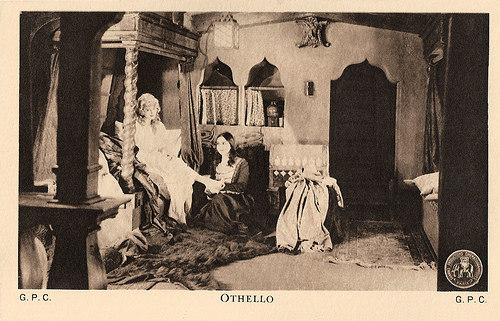
French postcard by Edition de la Cinematographie Française. Photo: Grandes Productions Cinématographiques (G.P.C.). Photo: publicity still for Othello (Dimitri Buchowetzki, 1922).
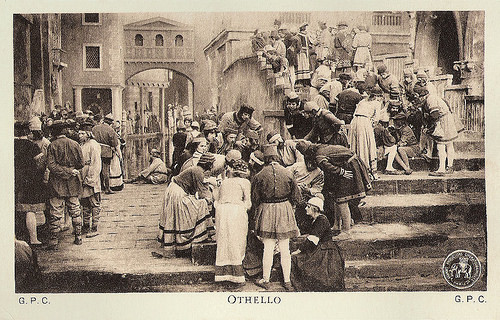
French postcard by Edition de la Cinematographie Française. Photo: Grandes Productions Cinématographiques (G.P.C.). Photo: publicity still for Othello (Dimitri Buchowetzki, 1922).
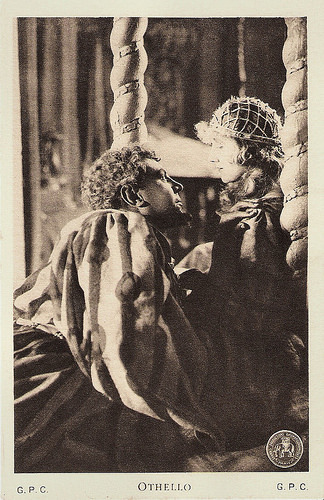
French postcard by Edition de la Cinematographie Française. Photo: Grandes Productions Cinématographiques (G.P.C.). Photo: publicity still for Othello (Dimitri Buchowetzki, 1922) with Emil Jannings and Ica von Lenkeffy.
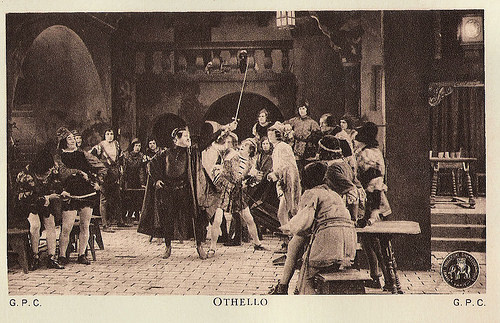
French postcard by Edition de la Cinematographie Française. Photo: Grandes Productions Cinématographiques (G.P.C.). Photo: publicity still for Othello (Dimitri Buchowetzki, 1922).
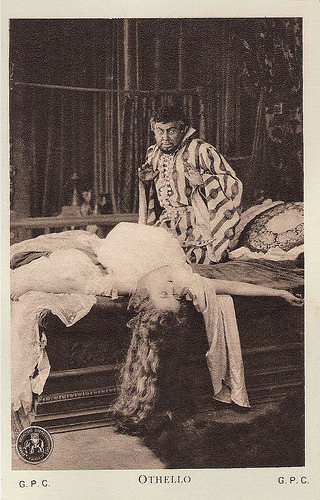
French postcard by Edition de la Cinematographie Française. Photo: Grandes Productions Cinématographiques (G.P.C.). Photo: publicity still for Othello (Dimitri Buchowetzki, 1922) with Emil Jannings and Ica von Lenkeffy.
Sources: Wes Connors (IMDb), Bret Wood (TCM) and IMDb.

French postcard by Edition de la Cinématographie-Française, Paris. Photo: G.P.C. Publicity still for Othello (Dimitri Buchowetzki, 1922) with Emil Jannings and Werner Krauss .

French postcard by Edition de la Cinematographie Française. Photo: Grandes Productions Cinématographiques (G.P.C.). Photo: publicity still for Othello (Dimitri Buchowetzki, 1922).

French postcard by Edition de la Cinematographie Française. Photo: Grandes Productions Cinématographiques (G.P.C.). Photo: publicity still for Othello (Dimitri Buchowetzki, 1922).

French postcard by Edition de la Cinematographie Française. Photo: Grandes Productions Cinématographiques (G.P.C.). Photo: publicity still for Othello (Dimitri Buchowetzki, 1922) with Theodor Loos and Ica von Lenkeffy.
Bitter jealousy
As Venice welcomes their victorious general, Othello the Moor ( Emil Jannings ), back to the city, some of them are waiting for Othello to choose his new lieutenant, while others are busy courting the popular Desdemona (Ica von Lenkeffy), the daughter of a Senator.
Othello chooses the loyal Cassio ( Theodor Loos ) as his lieutenant, arousing bitter jealousy in Iago ( Werner Krauss ), another soldier, who vows to scheme against his general. That same night, Othello elopes with Desdemona. Othello is soon sent to Cyprus to repel a Turkish invasion, and he arranges for Iago and his wife to bring Desdemona with them to Cyprus.
When Iago's wife learns of a treasured handkerchief that Othello gave to Desdemona, this provides Iago with an idea that he hopes will destroy Othello by provoking him to jealousy.
How can a filmmaker possibly retain the beauty of Shakespeare's prose without congesting the film with endless title cards? A non-dialogue Shakespeare film seems like a contradiction in terms, so very few silent adaptations of his plays have stood the test of time.
This German production of Othello (1922) has fared better than most, due largely to the combined talents of the actors Emil Jannings and Werner Krauss , and Russian-born director Dimitri Buchowetzki.
Wes Connors at IMDb : "The production is nicely staged, with everyone finding their marks. Its costumes and sets are very well designed. The adaptation is faithful enough to Shakespeare's envious storyline. But, watching two overly grand old actors is the film's main calling card, presently."

French postcard by Edition de la Cinematographie Française. Photo: Grandes Productions Cinématographiques (G.P.C.). Photo: publicity still for Othello (Dimitri Buchowetzki, 1922).

French postcard by Edition de la Cinematographie Française. Photo: Grandes Productions Cinématographiques (G.P.C.). Photo: publicity still for Othello (Dimitri Buchowetzki, 1922).

French postcard by Edition de la Cinematographie Française. Photo: Grandes Productions Cinématographiques (G.P.C.). Photo: publicity still for Othello (Dimitri Buchowetzki, 1922) with Emil Jannings and Ica von Lenkeffy.

French postcard by Edition de la Cinematographie Française. Photo: Grandes Productions Cinématographiques (G.P.C.). Photo: publicity still for Othello (Dimitri Buchowetzki, 1922).

French postcard by Edition de la Cinematographie Française. Photo: Grandes Productions Cinématographiques (G.P.C.). Photo: publicity still for Othello (Dimitri Buchowetzki, 1922) with Emil Jannings and Ica von Lenkeffy.
Sources: Wes Connors (IMDb), Bret Wood (TCM) and IMDb.
Published on May 01, 2018 22:00
April 30, 2018
Enrico Viarisio
Enrico Viarisio (1897-1967) was an Italian stage and screen actor, and cabaretier. In the sentimental comedies and white-telephone cinema of the 1930s, Viarisio was a constant figure, with his moustache and his black, shining hair combed to the back.
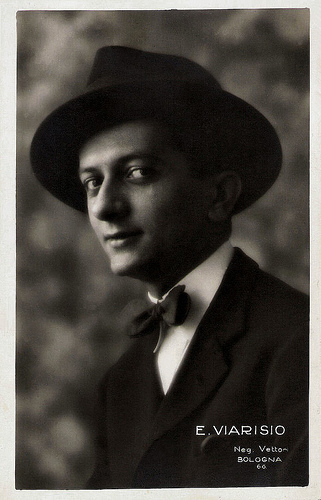
Italian postcard by Vettori, Bologna, no. 66.
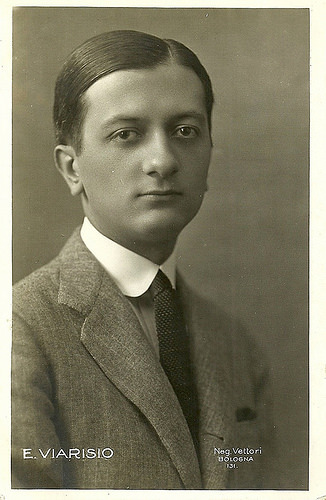
Italian postcard by Ed. Vettori, Bologna, no. 131.
Adventurous debut
Enrico Viarisio, born in Turin in 1897. Equipped with a fine and elegant humour, the 19-years-old Viarisio was discovered by actress and stage company director Paola Pezzaglia, who offered him his first theatrical engagement as in December 1916.
He debuted in an adventurous way: as the leading actor had missed the company’s rehearsals, Viarisio had to play all the important male parts. He then specialised in light entertainment and music-hall.
From the 1930s he has also worked in cinema, establishing himself as one of the most famous comical actors of sound cinema even if he was almost always relegated to secondary roles or antagonists.
Viarisio thus played opposite Elsa de Giorgi in L’impiegata di papà (Alessandro Blasetti, 1933), opposite Elsa Merlini and Vittorio De Sica in Paprika (Carl Boese, 1933) and Non ti conosco più/I Don't Know You Anymore (Nunzio Malasomma 1936), and again opposite Vittorio De Sica in Tempo massimo/Full Speed (Mario Mattoli, 1934) and L’uomo che sorride/The Man Who Smiles (Mario Mattoli, 1936).
Viarisio would act in many comedies by Mario Mattoli. By the later 1930s Viarisio had the male leads in comedies such as Musica in piazza/Music on the square (Mario Mattoli, 1937) with Milly and Gli ultimi giorni di Pompeo/The last days of Pompeo (Mario Mattoli 1937). Wikipedia : "Often he remained in the limits of the genre, but in some cases showed admirable creativity in his performances, keeping them fresh and memorable."
He also appeared in Il destino in tasca/Destiny in your pocket (Gennaro Righelli, 1938) with Vanna Vanni, Due milioni per un sorriso (Mario Soldati, Carlo Borghesio, 1939) with Elsa de Giorgi, L’eredità in corsa/The heritage on the run (Oreste Biancoli, 1939) with Antonio Gandusio, and L'amore si fa cosí/Love goes this way (Carlo Ludovico Bragalia 1939) with Colette Darfeuil .
In the early 1940s he played in Le sorprese del vagone letto (Gian Paolo Rosmino, 1940) with Clara Calamai , and Finalmente soli/Alone at last (Giacomo Gentilomo, 1942) – a kind of Italian variation on René Clair’s Un chapeau de paille d’Italie/The Ialian Straw Hat (1928), with a likewise frenetic protagonist.
Viarisio less frequently acted in dramatic films such as Cavalleria/Cavalry (Goffredo Alessandrini 1936), starring Amedeo Nazzari and Elisa Cegani. In Alessandro Blasetti’s proto-neorealist film Quatro passi fra le nuvole/Four Steps in the Clouds (1942) Viarisio is a streetwise travelling salesman like the protagonist Gino Cervi . In these dramas he didn’t have the lead, but was more often a comical sidekick.
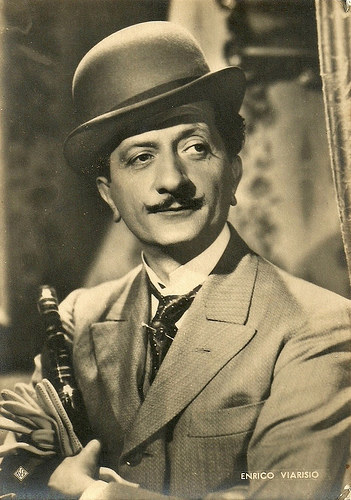
Italian postcard by ASER (A. Scaramaglia Edizioni, Roma), no. 144. Tirrenia, Photo: Gneme. 1940s. Famous were Viarisio's words in Prima comunione/First Communion (Alessandro Balsetti, 1950). When he, the man from the trolleybus was told: Aren't you ashamed to travel with that bowler hat?, he responded: And you, aren't you ashamed to travel with that face?!
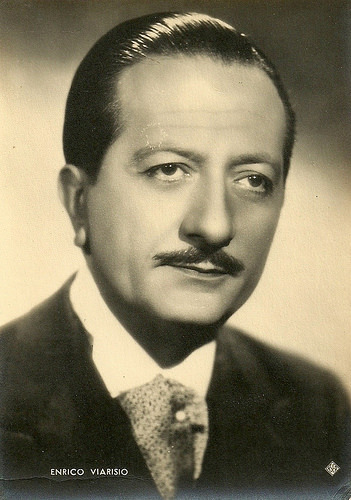
Italian postcard by ASER (A. Scaramaglia Edizioni, Roma), no. 267. Photo: Vaselli.
Oh-la-la, it’s a goody!
Enrico Viarisio was an elegant and slim character, recognizable by his perpetually pomaded hair and well-groomed mustache. He often played characters of noble decadence or the invading and sometimes annoying bon-vivant, even if basically an honest man. He was often mistaken for his colleague Giuseppe Porelli.
Until the end of the war Viarisio acted in some 44 Italian sound films. After the war his production slowed down, but in 1950 he played in four films, including the bitter-sweet comedy Prima comunione by Alessandro Blasetti and starring Aldo Fabrizi.
The 1950s were as fruitful for Viarisio as the 1930s. He continued his career onstage in revue shows, supporting such artists as Wanda Osiris, Olga Villi and Isa Barzizza. During the 1950s he also played in dozens of genre films, as well as some auteur films including I vitelloni (1953) by Federico Fellini with Viarisio as Moraldo's father, Stazione Termini/Terminal Station(1953) by Vittorio De Sica , Carosello napoletano/Neapolitan Carousel (Ettore Giannini 1954), and La ragazza del palio/The Love Specialist (Luigi Zampa 1957) with Diana Dors .
Afterwards Viarisio participated in numerous Musicarelli (Italian teen musicals) alongside famous pop stars (or singers who later became famous), like Mina , Bobby Solo, Gianni Morandi and Rita Pavone.
His most famous characterization of that period was that of the commercials shot for Alemagna sweets with Lia Zoppelli and Alberto Lionello, aired between 1957 till 1965 in Carosello, which always ended with the slogan "Ullallà, è una cuccagna!" (Oh-la-la, it’s a goody!).
Viarisio's last film part was as a general in Lina Wertmuller's Non stuzzicate la zanzara/Don't Sting the Mosquito (1966), with Rita Pavone and a young Giancarlo Giannini.
Enrico Viarisio died in 1967 in Rome. He was 69. He was married to Giuditta Marchetti.
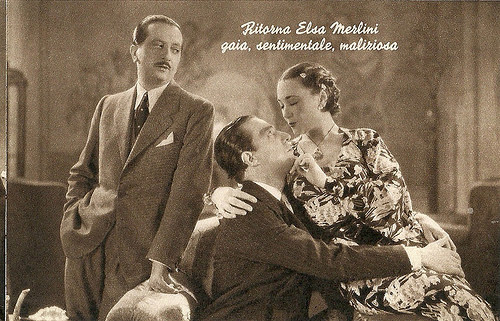
Italian postcard. Istituto Romano di Arti Grafiche Tumminelli & Co., Roma. Enrico Viarisio, Elsa Merlini and Vittorio De Sica in the Italian comedy Non ti conosco più (Nunzio Malasomma, 1936). The film was promoted as a return for Elsa Merlini , "gay, sentimental and malicious".
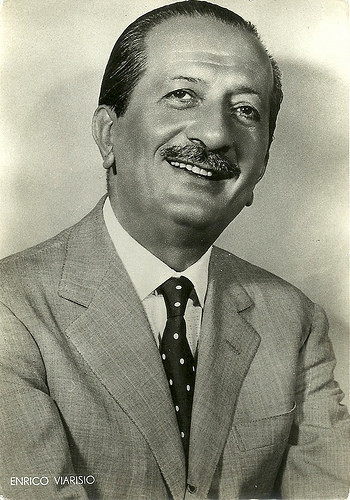
Italian postcard by Bromostampa, Milano, no. 379.
Carosella Allemagna. Source: Video Babele (YouTube).
Source: Wikipedia (Italian and English) and .

Italian postcard by Vettori, Bologna, no. 66.

Italian postcard by Ed. Vettori, Bologna, no. 131.
Adventurous debut
Enrico Viarisio, born in Turin in 1897. Equipped with a fine and elegant humour, the 19-years-old Viarisio was discovered by actress and stage company director Paola Pezzaglia, who offered him his first theatrical engagement as in December 1916.
He debuted in an adventurous way: as the leading actor had missed the company’s rehearsals, Viarisio had to play all the important male parts. He then specialised in light entertainment and music-hall.
From the 1930s he has also worked in cinema, establishing himself as one of the most famous comical actors of sound cinema even if he was almost always relegated to secondary roles or antagonists.
Viarisio thus played opposite Elsa de Giorgi in L’impiegata di papà (Alessandro Blasetti, 1933), opposite Elsa Merlini and Vittorio De Sica in Paprika (Carl Boese, 1933) and Non ti conosco più/I Don't Know You Anymore (Nunzio Malasomma 1936), and again opposite Vittorio De Sica in Tempo massimo/Full Speed (Mario Mattoli, 1934) and L’uomo che sorride/The Man Who Smiles (Mario Mattoli, 1936).
Viarisio would act in many comedies by Mario Mattoli. By the later 1930s Viarisio had the male leads in comedies such as Musica in piazza/Music on the square (Mario Mattoli, 1937) with Milly and Gli ultimi giorni di Pompeo/The last days of Pompeo (Mario Mattoli 1937). Wikipedia : "Often he remained in the limits of the genre, but in some cases showed admirable creativity in his performances, keeping them fresh and memorable."
He also appeared in Il destino in tasca/Destiny in your pocket (Gennaro Righelli, 1938) with Vanna Vanni, Due milioni per un sorriso (Mario Soldati, Carlo Borghesio, 1939) with Elsa de Giorgi, L’eredità in corsa/The heritage on the run (Oreste Biancoli, 1939) with Antonio Gandusio, and L'amore si fa cosí/Love goes this way (Carlo Ludovico Bragalia 1939) with Colette Darfeuil .
In the early 1940s he played in Le sorprese del vagone letto (Gian Paolo Rosmino, 1940) with Clara Calamai , and Finalmente soli/Alone at last (Giacomo Gentilomo, 1942) – a kind of Italian variation on René Clair’s Un chapeau de paille d’Italie/The Ialian Straw Hat (1928), with a likewise frenetic protagonist.
Viarisio less frequently acted in dramatic films such as Cavalleria/Cavalry (Goffredo Alessandrini 1936), starring Amedeo Nazzari and Elisa Cegani. In Alessandro Blasetti’s proto-neorealist film Quatro passi fra le nuvole/Four Steps in the Clouds (1942) Viarisio is a streetwise travelling salesman like the protagonist Gino Cervi . In these dramas he didn’t have the lead, but was more often a comical sidekick.

Italian postcard by ASER (A. Scaramaglia Edizioni, Roma), no. 144. Tirrenia, Photo: Gneme. 1940s. Famous were Viarisio's words in Prima comunione/First Communion (Alessandro Balsetti, 1950). When he, the man from the trolleybus was told: Aren't you ashamed to travel with that bowler hat?, he responded: And you, aren't you ashamed to travel with that face?!

Italian postcard by ASER (A. Scaramaglia Edizioni, Roma), no. 267. Photo: Vaselli.
Oh-la-la, it’s a goody!
Enrico Viarisio was an elegant and slim character, recognizable by his perpetually pomaded hair and well-groomed mustache. He often played characters of noble decadence or the invading and sometimes annoying bon-vivant, even if basically an honest man. He was often mistaken for his colleague Giuseppe Porelli.
Until the end of the war Viarisio acted in some 44 Italian sound films. After the war his production slowed down, but in 1950 he played in four films, including the bitter-sweet comedy Prima comunione by Alessandro Blasetti and starring Aldo Fabrizi.
The 1950s were as fruitful for Viarisio as the 1930s. He continued his career onstage in revue shows, supporting such artists as Wanda Osiris, Olga Villi and Isa Barzizza. During the 1950s he also played in dozens of genre films, as well as some auteur films including I vitelloni (1953) by Federico Fellini with Viarisio as Moraldo's father, Stazione Termini/Terminal Station(1953) by Vittorio De Sica , Carosello napoletano/Neapolitan Carousel (Ettore Giannini 1954), and La ragazza del palio/The Love Specialist (Luigi Zampa 1957) with Diana Dors .
Afterwards Viarisio participated in numerous Musicarelli (Italian teen musicals) alongside famous pop stars (or singers who later became famous), like Mina , Bobby Solo, Gianni Morandi and Rita Pavone.
His most famous characterization of that period was that of the commercials shot for Alemagna sweets with Lia Zoppelli and Alberto Lionello, aired between 1957 till 1965 in Carosello, which always ended with the slogan "Ullallà, è una cuccagna!" (Oh-la-la, it’s a goody!).
Viarisio's last film part was as a general in Lina Wertmuller's Non stuzzicate la zanzara/Don't Sting the Mosquito (1966), with Rita Pavone and a young Giancarlo Giannini.
Enrico Viarisio died in 1967 in Rome. He was 69. He was married to Giuditta Marchetti.

Italian postcard. Istituto Romano di Arti Grafiche Tumminelli & Co., Roma. Enrico Viarisio, Elsa Merlini and Vittorio De Sica in the Italian comedy Non ti conosco più (Nunzio Malasomma, 1936). The film was promoted as a return for Elsa Merlini , "gay, sentimental and malicious".

Italian postcard by Bromostampa, Milano, no. 379.
Carosella Allemagna. Source: Video Babele (YouTube).
Source: Wikipedia (Italian and English) and .
Published on April 30, 2018 22:00
April 29, 2018
Otto Mellies
Otto Mellies (1931) is a German actor and voice actor. For the DEFA, he appeared in several films during the 1950s and 1960s. He was also the German voice of Paul Newman.
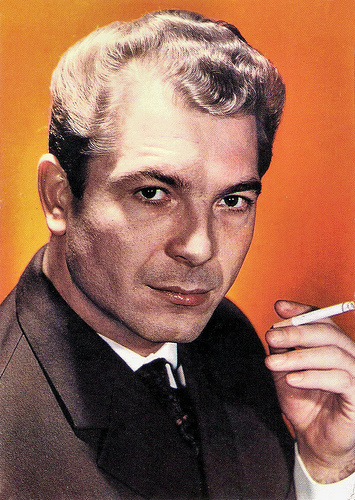
East-German postcard by VEB Progress Film-Vertrieb, Berlin, no. 2247, 1965. Photo: Schwarzer.
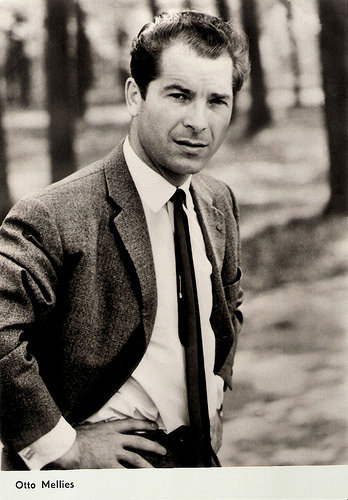
East-German postcard by VEB Progress Film-Vertrieb, Berlin, no. 2927, 1967. Photo: Balinski.
Nathan the Wise
Otto Ewald Ernst Mellies was born in 1931 in Schlawe (some sources say in nearby Stolp), Germany (now Slawno, Poland). His father was a hairdressing foreman.
A large part of his family died just before the end of the war (His mother, a sister an three of her children were murdered). He and his older brother, the later actor Eberhard Mellies, had to take care for themselves. The 14 years-old Otto worked as a caretaker for horses of Russian soldiers.
From 1947 to 1949, he attended the Staatliche Schauspielschule Schwerin (State Drama School in Schwerin) and followed lessons by director Lucie Höflich. His first employer in 1949 was the Mecklenburgisches Staatstheater Schwerin. His debut role was that of the student in Johann Wolfgang von Goethe's Faust.
He then played in Neustrelitz, Stralsund, Rostock and Erfurt. At the Stralsund Theater, Mellies debuted in 1951 in Gotthold Ephraim Lessing’s classic play Nathan der Weise (Nathan the Wise) in the role of the Temple Lord.
In 1956, theatre director Wolfgang Langhoff brought him to the Deutsches Theater, one of the most prominent companies in Berlin. He belonged to the ensemble for 50 years.
At the Deutsches Theater, he appeared in Henrik Ibsen's Peer Gynt, Jean-Paul Sartre's Die Fliegen/Les Mouches/The Flies and August Strindberg's Gespenstersonate/Spöksonaten/The Ghost Sonata. He repeatedly played under the direction of Jürgen Gosch and Thomas Langhoff.
He is best known as Nathan the Wise in the production of Friedo Solter. Lessing's Nathan the Wise was the showpiece with which the Deutsches Theater was reopened in 1945.
Since then, the play ran and ran, only the main actors changed: Paul Wegener, Eduard von Winterstein, Wolfgang Heinz - and from 1987 on Otto Mellies.
Otto Mellies performed Nathan in a black coat, black suit and white shirt. Under the black Kippa, he showed a bleak face with a three-day-beard. He has appeared thus in this role 325 times till 2005.
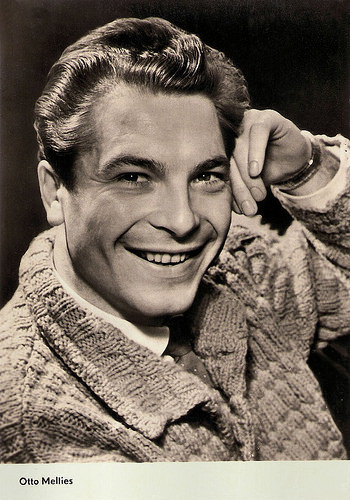
East-German postcard by VEB Progress Film-Vertrieb, Berlin, no. 1617, 1961. Photo: Paszkowiak.
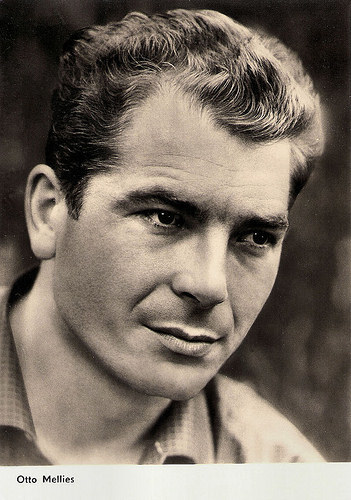
East-German postcard by VEB Progress Film-Vertrieb, Berlin, no. 2225, 1965. Photo: Schwarz.
Intrigue and Love
Since 1955, Otto Mellies is also working for the cinema. His debut film was the DEFA production Sommerliebe/Summer Love (Franz Barrenstein, 1955).
In 1960 he was awarded the Heinrich Greif Prize First Class for his role as Ferdinand in Kabale and Liebe/Intrigue and Love (Martin Hellberg, 1959).
Other popular films are the Jacques Offenbach-Operetta film Die schöne Lurette/Beautiful Lurette (Gottfried Kolditz, 1960) and the literature adaptation Minna von Barnhelm oder das Soldatenglück (Martin Hellberg, 1962).
In addition, Mellies works as a voice actor. After the death of Gert Günther Hoffmann he became the German voice of Paul Newman. In addition, he dubbed such actors as Christopher Lee , Michael Gambon, Maximilian Schell , Albert Finney , and Raf Vallone and also participated in numerous radio plays.
In 2012 he was awarded the Deutscher Filmpreis (German Film Award) for Best Supporting Actor for his role in Halt auf freier Strecke/Stopped on Track (Andreas Dresen, 2011).
Halt auf freier Strecke is a drama about a 44 years-old Berlin family man (played by Milan Peschel), who is slowly dying from a brain tumor. Mellies played Peschel's father. The film won several awards.
Since 2015, Mellies moderates the radio show Abschied ist ein leises Wort (Farewell is a quiet word).
The program commemorates recently deceased celebrities or public figures.
Otto Mellies lives in Berlin-Bohnsdorf, is married to former singer Luise and has two children.
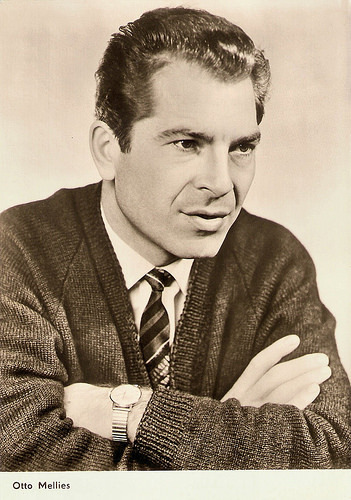
East-German postcard by VEB Progress Film-Vertrieb, Berlin, no. 2608, 1966. Photo: Gerbeth.
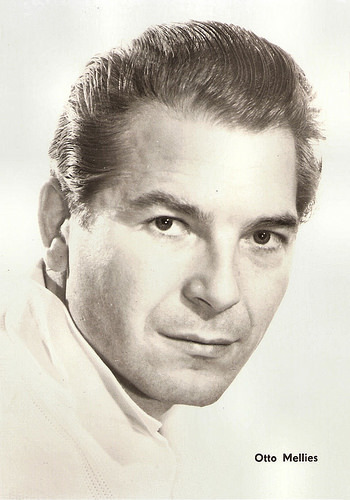
East-German postcard by VEB Progress Film-Vertrieb, Berlin, no. 64/69, 1969. Photo: Winkler.
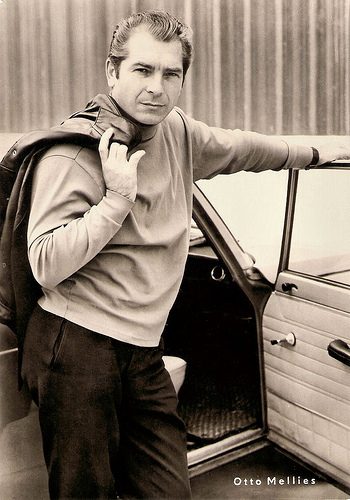
East-German postcard by VEB Progress Film-Vertrieb, Berlin, no. 202/70, 1970. Photo: Peters.
Sources: Christian Eger (Mitteldeutsche Zeitung - German), Ines Walk (Film-zeit.de – German), Wikipedia (German), and .

East-German postcard by VEB Progress Film-Vertrieb, Berlin, no. 2247, 1965. Photo: Schwarzer.

East-German postcard by VEB Progress Film-Vertrieb, Berlin, no. 2927, 1967. Photo: Balinski.
Nathan the Wise
Otto Ewald Ernst Mellies was born in 1931 in Schlawe (some sources say in nearby Stolp), Germany (now Slawno, Poland). His father was a hairdressing foreman.
A large part of his family died just before the end of the war (His mother, a sister an three of her children were murdered). He and his older brother, the later actor Eberhard Mellies, had to take care for themselves. The 14 years-old Otto worked as a caretaker for horses of Russian soldiers.
From 1947 to 1949, he attended the Staatliche Schauspielschule Schwerin (State Drama School in Schwerin) and followed lessons by director Lucie Höflich. His first employer in 1949 was the Mecklenburgisches Staatstheater Schwerin. His debut role was that of the student in Johann Wolfgang von Goethe's Faust.
He then played in Neustrelitz, Stralsund, Rostock and Erfurt. At the Stralsund Theater, Mellies debuted in 1951 in Gotthold Ephraim Lessing’s classic play Nathan der Weise (Nathan the Wise) in the role of the Temple Lord.
In 1956, theatre director Wolfgang Langhoff brought him to the Deutsches Theater, one of the most prominent companies in Berlin. He belonged to the ensemble for 50 years.
At the Deutsches Theater, he appeared in Henrik Ibsen's Peer Gynt, Jean-Paul Sartre's Die Fliegen/Les Mouches/The Flies and August Strindberg's Gespenstersonate/Spöksonaten/The Ghost Sonata. He repeatedly played under the direction of Jürgen Gosch and Thomas Langhoff.
He is best known as Nathan the Wise in the production of Friedo Solter. Lessing's Nathan the Wise was the showpiece with which the Deutsches Theater was reopened in 1945.
Since then, the play ran and ran, only the main actors changed: Paul Wegener, Eduard von Winterstein, Wolfgang Heinz - and from 1987 on Otto Mellies.
Otto Mellies performed Nathan in a black coat, black suit and white shirt. Under the black Kippa, he showed a bleak face with a three-day-beard. He has appeared thus in this role 325 times till 2005.

East-German postcard by VEB Progress Film-Vertrieb, Berlin, no. 1617, 1961. Photo: Paszkowiak.

East-German postcard by VEB Progress Film-Vertrieb, Berlin, no. 2225, 1965. Photo: Schwarz.
Intrigue and Love
Since 1955, Otto Mellies is also working for the cinema. His debut film was the DEFA production Sommerliebe/Summer Love (Franz Barrenstein, 1955).
In 1960 he was awarded the Heinrich Greif Prize First Class for his role as Ferdinand in Kabale and Liebe/Intrigue and Love (Martin Hellberg, 1959).
Other popular films are the Jacques Offenbach-Operetta film Die schöne Lurette/Beautiful Lurette (Gottfried Kolditz, 1960) and the literature adaptation Minna von Barnhelm oder das Soldatenglück (Martin Hellberg, 1962).
In addition, Mellies works as a voice actor. After the death of Gert Günther Hoffmann he became the German voice of Paul Newman. In addition, he dubbed such actors as Christopher Lee , Michael Gambon, Maximilian Schell , Albert Finney , and Raf Vallone and also participated in numerous radio plays.
In 2012 he was awarded the Deutscher Filmpreis (German Film Award) for Best Supporting Actor for his role in Halt auf freier Strecke/Stopped on Track (Andreas Dresen, 2011).
Halt auf freier Strecke is a drama about a 44 years-old Berlin family man (played by Milan Peschel), who is slowly dying from a brain tumor. Mellies played Peschel's father. The film won several awards.
Since 2015, Mellies moderates the radio show Abschied ist ein leises Wort (Farewell is a quiet word).
The program commemorates recently deceased celebrities or public figures.
Otto Mellies lives in Berlin-Bohnsdorf, is married to former singer Luise and has two children.

East-German postcard by VEB Progress Film-Vertrieb, Berlin, no. 2608, 1966. Photo: Gerbeth.

East-German postcard by VEB Progress Film-Vertrieb, Berlin, no. 64/69, 1969. Photo: Winkler.

East-German postcard by VEB Progress Film-Vertrieb, Berlin, no. 202/70, 1970. Photo: Peters.
Sources: Christian Eger (Mitteldeutsche Zeitung - German), Ines Walk (Film-zeit.de – German), Wikipedia (German), and .
Published on April 29, 2018 22:00
April 28, 2018
Ivan Desny
French-German actor Ivan Desny (1922-2002) was a cosmopolitan film star with a truly European film career that spanned four decades. In the years after the war he appeared in British, French, Italian and German films before he became one of the protagonists of the Neue Deutsche Welle - the German New Wave of the 1970s.
<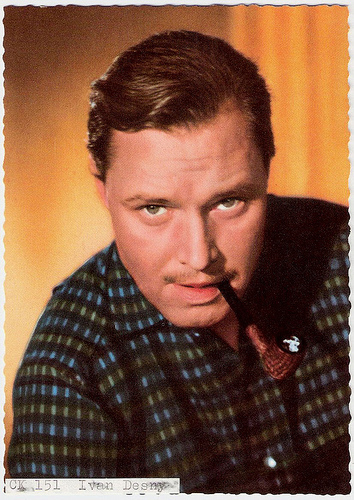
German postcard by UFA/Film-Foto (Universum-Film Aktiengesellschaft, Berlin-Tempelhof), no. CK-151. Photo: Arthur Grimm / UFA.
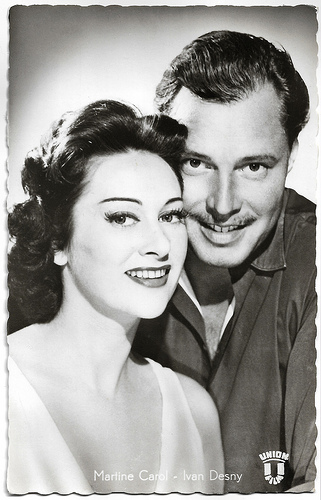
German postcard by Kolibri-Verlag G.m.b.H. Minden/Westf., no. 1719. Photo: Gamma / Union / Vogelmann. Publicity still for Lola Montez (Max Ophüls, 1955) with Martine Carol .
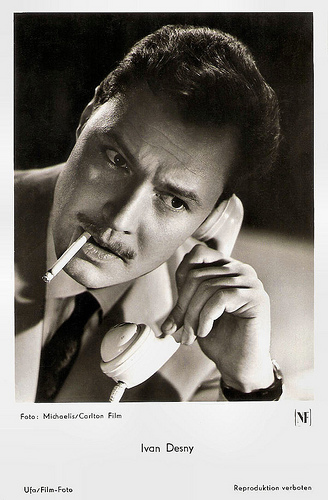
German postcard by Ufa, Berlin-Tempelhof, no. FK 3021. Photo: Michaelis / Carlton Film / NF. Publicity still for Rosen für Bettina/Ballerina (Georg Wilhelm Pabst, 1956).
Blackmailing Social Climber
Ivan Desny was born as Ivan Nikolai Desnitzky in Peking (now Beijing), China, in 1922. He was the son of a Russian diplomat and a Swedish mother. As a child he lived in in Teheran, Washington, Paris and Brisbane.
It was his bad luck to be in Paris when the Nazis marched in. He spent the war in a German labor camp along with thousands of other Russian expatriates.
After the war he broke up his law studies and followed acting classes in Paris. He made his stage debut at the famous boulevard theatre Théâtre de la Michodière under Pierre Fresnay .
He drifted into French films, first as an extra and as a costume and set designer, then as the leading man in the lost film La fleur de l'âge/The Flower of Youth (Marcel Carné, 1947) with Anouk Aimée and Arletty . The shooting of the film started several times, and was halted for censorship reasons (the project was banned by the Ministry of Justice) and harsh shooting conditions, and finally it was abandoned. All material was inexplicably lost in the 1950s.
Desny then appeared in Bonheur en location/Happiness on Location (Jean Wall, 1949), and soon started an international career.
In London he appeared as the blackmailing social climber Emile l'Angelier in Madeleine (David Lean, 1950) with Ann Todd. In France he starred in La putain respectueuse/The Respectful Prostitute (Charles Brabant, Marcello Pagliero, 1952), based on the play by Jean-Paul Sartre, and in Italy in La signora senza camelie/The Lady Without Camelias (Michelangelo Antonioni, 1953) with Lucia Bosé .
Then he went to Germany to appear as a Russian Army officer in Berlin after the war in Weg ohne Umkehr/No Way Back (Victor Vicas, Beate von Molo, 1953). The film won two German film awards and a Golden Globe as Best Foreign Film.
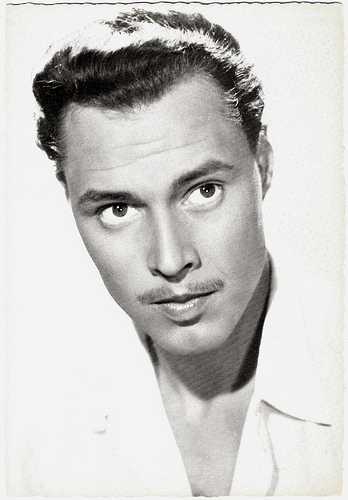
German postcard by WS-Druck, Wanne-Eickel, no. 393.
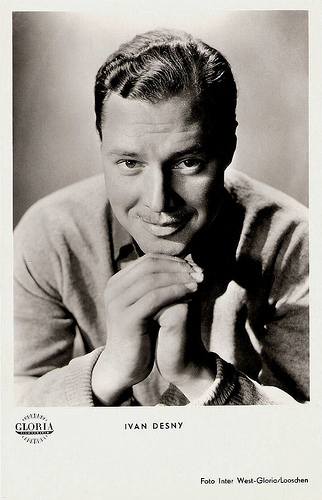
German postcard by Kunst und Bild, Wanne-Eickel, no. A 1321. Photo: Inter West-Gloria / Looschen. Publicity still for Herr über Leben und Tod/Master Over Life and Death (Victor Vicas, 1955).
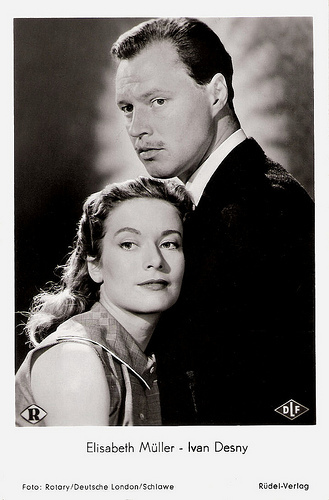
German postcard by Rüdel-Verlag, Hamburg-Bergedorf, no. 1364. Photo: Rotary / Deutsche London / Schlawe. Publicity still for André und Ursula/Andre and Ursula (Werner Jacobs, 1955) with Elisabeth Müller.
Cosmopolitan Ladykiller
In the following years, Ivan Desny became popular as a cosmopolitan ladykiller with his goatee and a foreign accent. He starred opposite Maria Schell in Herr über Leben und Tod/Master Over Life and Death (Victor Vicas, 1955), opposite Elisabeth Müller in André und Ursula/ André and Ursula (Werner Jacobs, 1955), and opposite Sonja Ziemann in Mädchen ohne Grenzen/A Girl Without Boundaries (Géza von Radványi, 1955).
He also appeared in the masterpiece Lola Montès (Max Ophüls, 1955) with Martine Carol .
Then he played leading parts in two hits by Falk Harnack, Anastasia – die letzte Zarentochter/Anastasia: The Czar's Last Daughter (1956) and Wie ein Sturmwind/Tempestuous Love (1957). His partner in both films was Lilli Palmer . He also appeared in the Hollywood version of Anastasia (Anatole Litvak, 1956) starring Ingrid Bergman and Yul Brynner .
Other films in which he played were Une Vie/One Life (Alexandre Astruc, 1958) starring Maria Schell and Pascale Petit , Le miroir à deux faces/The Mirror Has Two Faces (André Cayatte, 1958) with Michèle Morgan and Bourvil , and the crime film Heiße Ware/Hot Stuff (Paul May, 1959) with Margit Saad .
He also appeared in Hollywood productions like the award winning Song Without End (Charles Vidor, 1960) about the affairs of composer Franz Liszt played by Dirk Bogarde , and the Disney film Bon Voyage! (James Neilson, 1962) about the one-of-a-lifetime vacation in Paris of Fred MacMurray and Jane Wyman.
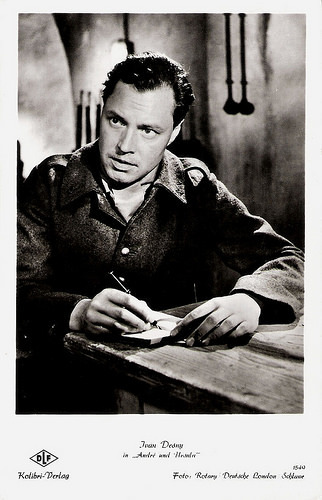
German postcard by Kolibri-Verlag, no. 1540. Photo: Rotary / Deutsche London / Schluwe. Publicity still for André und Ursula/Andre and Ursula (Werner Jacobs, 1955).
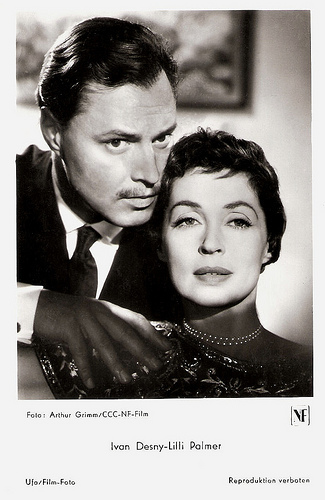
German postcard by Ufa, Wanne-Eickel, no. 393. Photo: Arthur Grimm / CCC / NF-Film. Publicity still for Anastasia - Die letzte Zarentochter/Anastasia: The Czar's Last Daughter (Falk Harnack, 1956) with Lilli Palmer .

German postcard by Kolibri-Verlag G.m.b.H., Minden/Westf., no. 2531. Photo: Deutsche Cosmopol-Film. Publicity still for O.S.S. 117 n'est pas mort/O.S.S. 117 Is Not Dead (Jean Sacha, 1957) with Magali Noël .
Neue Deutsche Welle
During the decline of the German cinema in the 1960s and 1970s, Ivan Desny focused on stage and television work. In the theatres he often appeared with Nadja Tiller .
Meanwhile he showed up in small roles in such international pictures as La bataille de San Sebastian/The Battle of San Sebastian/Guns for San Sebastian (Henri Verneuil, 1968) with Anthony Quinn and Charles Bronson, Mayerling (Terence Young, 1968) with Omar Sharif and Catherine Deneuve , and Little Mother (Radley Metzger, 1973), based on the life story of Evita Peron.
In the early years of the popular Krimi TV-series Tatort (1971-1973), he regularly appeared as the mysterious Mr. Sievers, the brain after many criminal activities, who seemed untouchable.
Then he was discovered by the young directors of the Neue Deutsche Welle. Rainer Werner Fassbinder gave him a part in Welt am Draht/World on a Wire (1973) and in his masterpieces Die Ehe der Maria Braun/The Marriage of Maria Braun (1978) starring Hanna Schygulla , and Lola (1981) starring Barbara Sukowa. Desny also had a part in Fassbinder’s monumental TV series Berlin Alexanderplatz (1980).
Klaus Lemke cast him in his TV film Sylvie (1973), and Wim Wenders engaged him for Falsche Bewegung/False Movement (1975).
Other films in which he appeared were the Sci-Fi film Who? (Jack Gold, 1973) with b>Elliott Gould, the thriller Touch Me Not (Douglas Fithian, 1974) with Lee Remick, Paper Tiger (Ken Annakin, 1975) with David Niven , Die Eroberung der Zitadelle/The Conquest of the Citadel (Bernhard Wicki, 1977), Bloodline (Terence Young, 1979) with Audrey Hepburn , and Malou (Jeanine Meerapfel, 1980) with Ingrid Caven.
In 1980 the Frenchman Desny was awarded the German award Filmband in Gold for his longtime and outstanding attributions to the German cinema. Among his later films were Flügel und Fesseln/The Future of Emily (Helma Sanders-Brahms, 1985) with Brigitte Fossey and Hildegard Knef , the Anton Checkhov adaptation Hôtel de France (Patrice Chéreau, 1987), and the thriller Quicker Than the Eye (Nicolas Gessner, 1989) with Ben Gazzara.
He also appeared in the biography God afton, Herr Wallenberg - En Passionshistoria från verkligheten/Good Evening, Mr. Wallenberg (Kjell Grede, 1990) starring Stellan Skarsgård as the mysterious WW II hero Raoul Wallenberg, La Désenchantée/The Disenchanted (Benoit Jacquot, 1990), and André Téchiné’s dramas J'embrasse pas/I Don't Kiss (1991) with Emmanuelle Béart , and Les Voleurs/Thieves (1996) with Catherine Deneuve .
In 2002 Desny got a lot of criticism for appearing in a magazine article as a healed cancer patient (which he wasn’t) and for advertising a controversial and in Germany forbidden anti-cancer compound, Galavit, as a miracle cure.
That same year Ivan Desny died of pneumonia in Ascona, Switzerland. He had appeared in over 150 films.
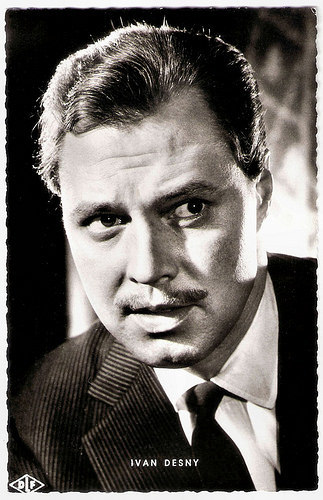
German postcard by Kunst und Bild, Berlin, no. S 588. Photo: Alfu / Corona / Deutsche London / Grimm. Publicity still for Anastasia - Die letzte Zarentochter/Anastasia (Falk Harnack, 1956). Ivan Desny, who appears here as the real-life Gleb Botkin (son of the Imperial family's doctor, who was shot along with them in 1918), also appears as the fictional Prince Paul Von Haraldsberg in the Ingrid Bergman film Anastasia (Anatole Litvak, 1956).
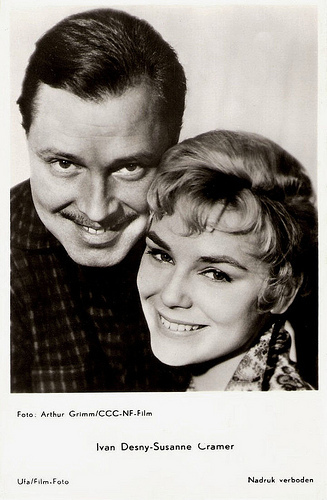
Dutch postcard by Gebr. Spanjersberg N.V., Rotterdam, no. 3305. Photo: Arthur Grimm / CCC / NF-Film. Spanjersberg was the Dutch licency holder for Ufa/Film-Foto (Universum-Film Aktiengesellschaft, Berlin-Tempelhof). Publicity still for Wie ein Sturmwind/Tempestuous Love (Falk Harnack, 1957) with Susanne Cramer .
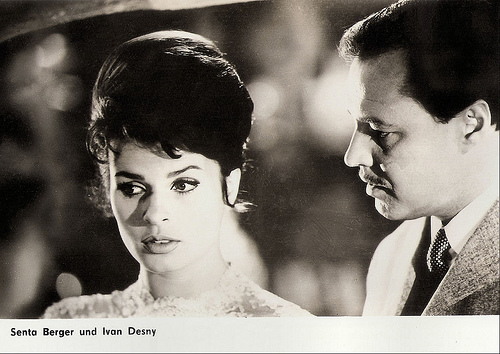
East-German postcard by VEB Progress Filmvertrieb, Berlin, no. 3012, 1967 Photo: publicity still for Sherlock Holmes und das Halsband des Todes/Sherlock Holmes and the Deadly Necklace (Terence Fisher, 1962) with Senta Berger .
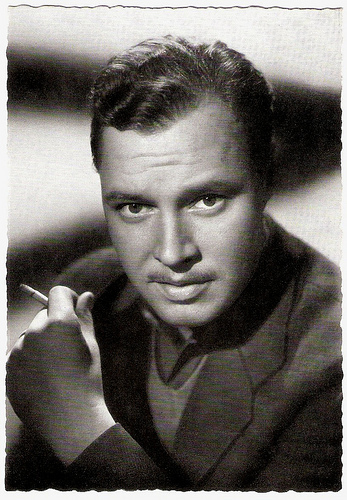
German postcard by WS-Druck, Wanne-Eickel, no. 13. Photo: Inter West-Gloria / List / Looschen.
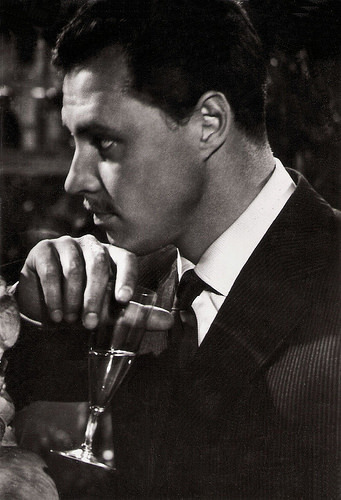
German photo.
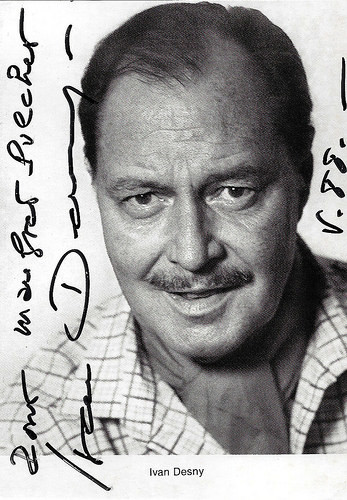
German postcard by Franz Josef Rüdel, Filmpostkartenverlag, Hamburg. Photo: Hilde Zemann, München (Munich).
Sources: Hal Erickson (AllMovie), Deutsches-Filmhaus.de (German), Wikipedia (German), and .
<

German postcard by UFA/Film-Foto (Universum-Film Aktiengesellschaft, Berlin-Tempelhof), no. CK-151. Photo: Arthur Grimm / UFA.

German postcard by Kolibri-Verlag G.m.b.H. Minden/Westf., no. 1719. Photo: Gamma / Union / Vogelmann. Publicity still for Lola Montez (Max Ophüls, 1955) with Martine Carol .

German postcard by Ufa, Berlin-Tempelhof, no. FK 3021. Photo: Michaelis / Carlton Film / NF. Publicity still for Rosen für Bettina/Ballerina (Georg Wilhelm Pabst, 1956).
Blackmailing Social Climber
Ivan Desny was born as Ivan Nikolai Desnitzky in Peking (now Beijing), China, in 1922. He was the son of a Russian diplomat and a Swedish mother. As a child he lived in in Teheran, Washington, Paris and Brisbane.
It was his bad luck to be in Paris when the Nazis marched in. He spent the war in a German labor camp along with thousands of other Russian expatriates.
After the war he broke up his law studies and followed acting classes in Paris. He made his stage debut at the famous boulevard theatre Théâtre de la Michodière under Pierre Fresnay .
He drifted into French films, first as an extra and as a costume and set designer, then as the leading man in the lost film La fleur de l'âge/The Flower of Youth (Marcel Carné, 1947) with Anouk Aimée and Arletty . The shooting of the film started several times, and was halted for censorship reasons (the project was banned by the Ministry of Justice) and harsh shooting conditions, and finally it was abandoned. All material was inexplicably lost in the 1950s.
Desny then appeared in Bonheur en location/Happiness on Location (Jean Wall, 1949), and soon started an international career.
In London he appeared as the blackmailing social climber Emile l'Angelier in Madeleine (David Lean, 1950) with Ann Todd. In France he starred in La putain respectueuse/The Respectful Prostitute (Charles Brabant, Marcello Pagliero, 1952), based on the play by Jean-Paul Sartre, and in Italy in La signora senza camelie/The Lady Without Camelias (Michelangelo Antonioni, 1953) with Lucia Bosé .
Then he went to Germany to appear as a Russian Army officer in Berlin after the war in Weg ohne Umkehr/No Way Back (Victor Vicas, Beate von Molo, 1953). The film won two German film awards and a Golden Globe as Best Foreign Film.

German postcard by WS-Druck, Wanne-Eickel, no. 393.

German postcard by Kunst und Bild, Wanne-Eickel, no. A 1321. Photo: Inter West-Gloria / Looschen. Publicity still for Herr über Leben und Tod/Master Over Life and Death (Victor Vicas, 1955).

German postcard by Rüdel-Verlag, Hamburg-Bergedorf, no. 1364. Photo: Rotary / Deutsche London / Schlawe. Publicity still for André und Ursula/Andre and Ursula (Werner Jacobs, 1955) with Elisabeth Müller.
Cosmopolitan Ladykiller
In the following years, Ivan Desny became popular as a cosmopolitan ladykiller with his goatee and a foreign accent. He starred opposite Maria Schell in Herr über Leben und Tod/Master Over Life and Death (Victor Vicas, 1955), opposite Elisabeth Müller in André und Ursula/ André and Ursula (Werner Jacobs, 1955), and opposite Sonja Ziemann in Mädchen ohne Grenzen/A Girl Without Boundaries (Géza von Radványi, 1955).
He also appeared in the masterpiece Lola Montès (Max Ophüls, 1955) with Martine Carol .
Then he played leading parts in two hits by Falk Harnack, Anastasia – die letzte Zarentochter/Anastasia: The Czar's Last Daughter (1956) and Wie ein Sturmwind/Tempestuous Love (1957). His partner in both films was Lilli Palmer . He also appeared in the Hollywood version of Anastasia (Anatole Litvak, 1956) starring Ingrid Bergman and Yul Brynner .
Other films in which he played were Une Vie/One Life (Alexandre Astruc, 1958) starring Maria Schell and Pascale Petit , Le miroir à deux faces/The Mirror Has Two Faces (André Cayatte, 1958) with Michèle Morgan and Bourvil , and the crime film Heiße Ware/Hot Stuff (Paul May, 1959) with Margit Saad .
He also appeared in Hollywood productions like the award winning Song Without End (Charles Vidor, 1960) about the affairs of composer Franz Liszt played by Dirk Bogarde , and the Disney film Bon Voyage! (James Neilson, 1962) about the one-of-a-lifetime vacation in Paris of Fred MacMurray and Jane Wyman.

German postcard by Kolibri-Verlag, no. 1540. Photo: Rotary / Deutsche London / Schluwe. Publicity still for André und Ursula/Andre and Ursula (Werner Jacobs, 1955).

German postcard by Ufa, Wanne-Eickel, no. 393. Photo: Arthur Grimm / CCC / NF-Film. Publicity still for Anastasia - Die letzte Zarentochter/Anastasia: The Czar's Last Daughter (Falk Harnack, 1956) with Lilli Palmer .

German postcard by Kolibri-Verlag G.m.b.H., Minden/Westf., no. 2531. Photo: Deutsche Cosmopol-Film. Publicity still for O.S.S. 117 n'est pas mort/O.S.S. 117 Is Not Dead (Jean Sacha, 1957) with Magali Noël .
Neue Deutsche Welle
During the decline of the German cinema in the 1960s and 1970s, Ivan Desny focused on stage and television work. In the theatres he often appeared with Nadja Tiller .
Meanwhile he showed up in small roles in such international pictures as La bataille de San Sebastian/The Battle of San Sebastian/Guns for San Sebastian (Henri Verneuil, 1968) with Anthony Quinn and Charles Bronson, Mayerling (Terence Young, 1968) with Omar Sharif and Catherine Deneuve , and Little Mother (Radley Metzger, 1973), based on the life story of Evita Peron.
In the early years of the popular Krimi TV-series Tatort (1971-1973), he regularly appeared as the mysterious Mr. Sievers, the brain after many criminal activities, who seemed untouchable.
Then he was discovered by the young directors of the Neue Deutsche Welle. Rainer Werner Fassbinder gave him a part in Welt am Draht/World on a Wire (1973) and in his masterpieces Die Ehe der Maria Braun/The Marriage of Maria Braun (1978) starring Hanna Schygulla , and Lola (1981) starring Barbara Sukowa. Desny also had a part in Fassbinder’s monumental TV series Berlin Alexanderplatz (1980).
Klaus Lemke cast him in his TV film Sylvie (1973), and Wim Wenders engaged him for Falsche Bewegung/False Movement (1975).
Other films in which he appeared were the Sci-Fi film Who? (Jack Gold, 1973) with b>Elliott Gould, the thriller Touch Me Not (Douglas Fithian, 1974) with Lee Remick, Paper Tiger (Ken Annakin, 1975) with David Niven , Die Eroberung der Zitadelle/The Conquest of the Citadel (Bernhard Wicki, 1977), Bloodline (Terence Young, 1979) with Audrey Hepburn , and Malou (Jeanine Meerapfel, 1980) with Ingrid Caven.
In 1980 the Frenchman Desny was awarded the German award Filmband in Gold for his longtime and outstanding attributions to the German cinema. Among his later films were Flügel und Fesseln/The Future of Emily (Helma Sanders-Brahms, 1985) with Brigitte Fossey and Hildegard Knef , the Anton Checkhov adaptation Hôtel de France (Patrice Chéreau, 1987), and the thriller Quicker Than the Eye (Nicolas Gessner, 1989) with Ben Gazzara.
He also appeared in the biography God afton, Herr Wallenberg - En Passionshistoria från verkligheten/Good Evening, Mr. Wallenberg (Kjell Grede, 1990) starring Stellan Skarsgård as the mysterious WW II hero Raoul Wallenberg, La Désenchantée/The Disenchanted (Benoit Jacquot, 1990), and André Téchiné’s dramas J'embrasse pas/I Don't Kiss (1991) with Emmanuelle Béart , and Les Voleurs/Thieves (1996) with Catherine Deneuve .
In 2002 Desny got a lot of criticism for appearing in a magazine article as a healed cancer patient (which he wasn’t) and for advertising a controversial and in Germany forbidden anti-cancer compound, Galavit, as a miracle cure.
That same year Ivan Desny died of pneumonia in Ascona, Switzerland. He had appeared in over 150 films.

German postcard by Kunst und Bild, Berlin, no. S 588. Photo: Alfu / Corona / Deutsche London / Grimm. Publicity still for Anastasia - Die letzte Zarentochter/Anastasia (Falk Harnack, 1956). Ivan Desny, who appears here as the real-life Gleb Botkin (son of the Imperial family's doctor, who was shot along with them in 1918), also appears as the fictional Prince Paul Von Haraldsberg in the Ingrid Bergman film Anastasia (Anatole Litvak, 1956).

Dutch postcard by Gebr. Spanjersberg N.V., Rotterdam, no. 3305. Photo: Arthur Grimm / CCC / NF-Film. Spanjersberg was the Dutch licency holder for Ufa/Film-Foto (Universum-Film Aktiengesellschaft, Berlin-Tempelhof). Publicity still for Wie ein Sturmwind/Tempestuous Love (Falk Harnack, 1957) with Susanne Cramer .

East-German postcard by VEB Progress Filmvertrieb, Berlin, no. 3012, 1967 Photo: publicity still for Sherlock Holmes und das Halsband des Todes/Sherlock Holmes and the Deadly Necklace (Terence Fisher, 1962) with Senta Berger .

German postcard by WS-Druck, Wanne-Eickel, no. 13. Photo: Inter West-Gloria / List / Looschen.

German photo.

German postcard by Franz Josef Rüdel, Filmpostkartenverlag, Hamburg. Photo: Hilde Zemann, München (Munich).
Sources: Hal Erickson (AllMovie), Deutsches-Filmhaus.de (German), Wikipedia (German), and .
Published on April 28, 2018 22:00
April 27, 2018
Jean Hersholt
Jean Hersholt (1886-1956) was a Danish-born actor who lived in the United States, where he appeared in 75 silent films and 65 sound films and directed four films. He was best known for his villain role in Erich von Stroheim's classic Greed (1924) and as Shirley Temple's grandfather in Heidi (1937). For 17 years he starred on American radio in Dr. Christian.
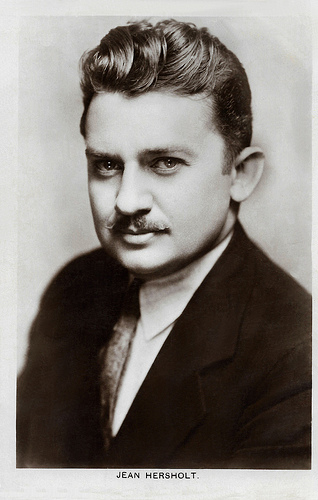
British postcard in the Picturegoer series, London, no. 360.
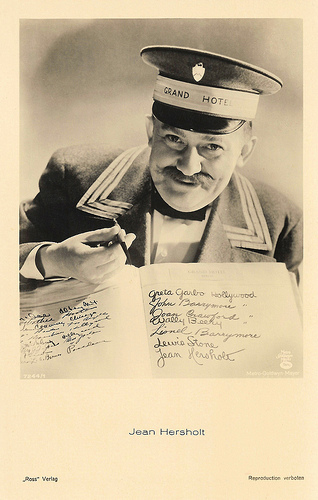
German postcard by Ross Verlag, no. 7244/1, 1932-1933, distributed in Italy by Casa Editrice Ballerini & Fratini, Firenze. Photo: Metro-Goldwyn-Mayer. Publicity still for Grand Hotel (Edmund Goulding, 1932).
The slimiest and most monstrous of movie villains
Jean Buron Hersholt (sources differ about his middle name) was born in Copenhagen, Denmark, in 1886. His father was a cigar salesman and his mother a singing girl. He graduated from the Copenhagen Art School.
His first three short films were made for the Nordisk Film Kompagni in Denmark in 1906. These were Professorens Morgenavis/Professor's morning newspaper (Louis Halberstadt, Viggo Larsen, 1906) with Max Freitag, Konfirmanden/Confirmand (Louis Halberstadt, 1906) and En ny hat til Madammen/A New Hat for Madam (Viggo Larsen, 1906).
He emigrated to the US in 1913, and the remainder of his films were made in America. He was an extra in early silent films Westerns like The Disciple (William S. Hart, 1915), Hell's Hinges (Charles Swickard, William S. Hart and Clifford Smith, 1916) and The Aryan (William S. Hart, 1916), both starring William S. Hart and produced by Thomas H. Ince. He played a priest in the silent Western The Soul Herder (John Ford, 1917) featuring Harry Carey.
By the 1920s his roles were substantial feature pieces, but most of these were as villains. Hal Erickson at AllMovie : “Hersholt was firmly entrenched as the slimiest and most monstrous of movie villains.”
He had one of his first leading roles as the servant in the silent drama The Servant in the House (Jack Conway, 1921) based on a 1908 Broadway play, The Servant in the House by Charles Rann Kennedy. The film was already shot in 1918 by the historic Triangle Film Corporation, but by 1920, Triangle had gone out of business. The film had a limited release in mid-1920 and was acquired by a different distributor in late 1920 for re-release in 1921. Then followed supporting parts in films like the drama Jazzmania (Robert Z. Leonard, 1923) starring Mae Murray.
Hersholt's best-remembered silent film is Greed (Erich von Stroheim, 1924) based on the 1899 Frank Norris novel McTeague. It stars Gibson Gowland as Dr. John McTeague, ZaSu Pitts as Trina Sieppe, his wife, and Hersholt as McTeague's friend and eventual enemy Marcus Schouler. Greed was one of the few films of its time to be shot entirely on location, with Von Stroheim shooting approximately 85 hours of footage before editing. Two months alone were spent shooting in Death Valley for the film's final sequence, and many of the cast and crew became ill.
According to William McPeak at IMDb , Hersholt endured the heat like a veteran but required a hospital stay after sweating away 27 pounds. Von Stroheim used sophisticated filming techniques such as deep-focus cinematography and montage editing. He considered Greed to be a Greek tragedy, in which environment and heredity controlled the characters' fates and reduced them to primitive bête humaines (human beasts). Greed was a critical and financial failure upon its initial release, but by the 1950s it began to be regarded as one of the greatest films ever made.
In the silent drama Stella Dallas (Henry King, 1925), Hersholt co-starred with Ronald Colman , Belle Bennett and Douglas Fairbanks Jr. Other silent films were My Old Dutch (Laurence Trimble, 1926), the crime drama The Old Soak (Edward Sloman, 1926) and Alias the Deacon (Edward Sloman, 1927).
Ernst Lubitsch directed him in The Student Prince in Old Heidelberg (1927) as the tutor of Ramón Novarro . Though now considered a classic by many film historians, it was far from a unanimous critical success during its original theatrical run.
In the silent romantic-comedy 13 Washington Square (Melville W. Brown, 1928) he starred with Alice Joyce and ZaSu Pitts, and in The Secret Hour (Rowland V. Lee, 1928) with Pola Negri . He was directed by legendary D.W. Griffith in the comedy The Battle of the Sexes (1928) a remake by Griffith of an earlier film he directed in 1914, which starred Lillian Gish . The film was released as both a silent film, and in a sound version using the Movietone sound-on-film system. He then starred in the part-talkie drama The Younger Generation (1929) directed by Frank Capra.
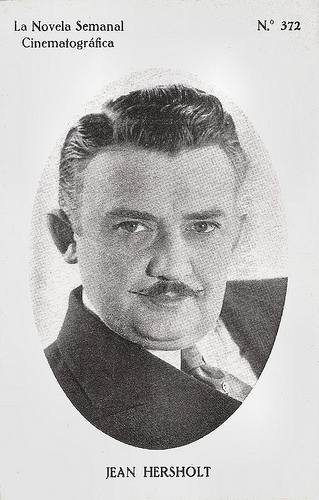
Spanish card by La Novela Semanal Cinematográfica, no. 372.
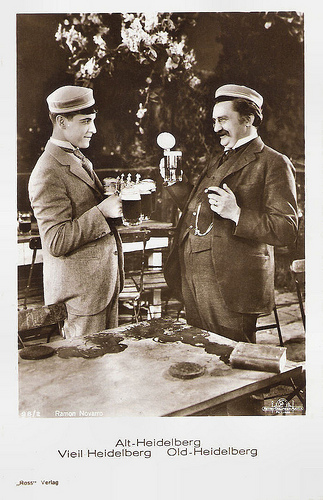
German postcard by Ross Verlag, no. 98/2. Photo: Metro-Goldwyn-Mayer. Publicity still for The Student Prince of Old Heidelberg (Ernst Lubitsch, 1927) with Ramón Novarro .
A camera friendly presence
Jean Hersholt’s first all mono sound film was The Climax (Renaud Hoffman, 1930) with Kathryn Crawford as a young Italian girl who wants to become a great opera singer. Despite his Danish accent, Hersholt had a pleasant, mellow voice and a camera friendly presence that ensured him continued success.
He co-starred in the action-adventure The Third Alarm (Emory Johnson, 1930) with Anita Louise and produced and released by Tiffany Pictures, a faltering B movie silent studio that tried to become a major.
For United Artists he co-starred with Lupe Velez in Hell Harbor (Henry King, 1930) and for MGM with Greta Garbo and Clark Gable in Susan Lenox (Her Fall and Rise) (Robert Z. Leonard, 1931). He supported Boris Karloff and Myrna Loy in The Mask of Fu Manchu (Charles Brabin, 1932), and Marie Dressler and Jean Harlow in Dinner at Eight (George Cukor, 1933).
He played Senf, the porter, in Grand Hotel (Edmund Goulding, 1932), also with Greta Garbo , and reunited with Clark Gable in Men in White (Ryszard Bolesławski, 1934).
In The Country Doctor (Henry King, 1936), starring the Canadian Dionne quintuplets, Hersholt portrayed Dr. John Luke, a character based on Dr. Allan Roy Dafoe, the obstetrician who delivered and cared for the Dionne quintuplets. Two sequels followed.
Hersholt wanted to do the role on radio, but could not get the rights. He decided to create his own doctor character for radio, and since he was a Hans Christian Andersen enthusiast, he borrowed that name for his character of the philosophical Dr. Paul Christian who practised in the Midwest town of River's End with the assistance of Nurse Judy Price.
Dr. Christian was introduced on CBS in 1937. The radio series became a popular long-running hit, continuing on CBS until 6 January 1954, with Hersholt so strongly identified with the role that he received mail asking for medical advice. Various spin-offs were produced, as Hersholt co-wrote a Dr. Christian novel and made a series of six family films as Christian from 1939 to 1941, for instance Dr. Christian Meets the Women in 1940. In 1956, his Dr. Christian character made the transition to television, scripted by Gene Roddenberry, with Macdonald Carey as his nephew.
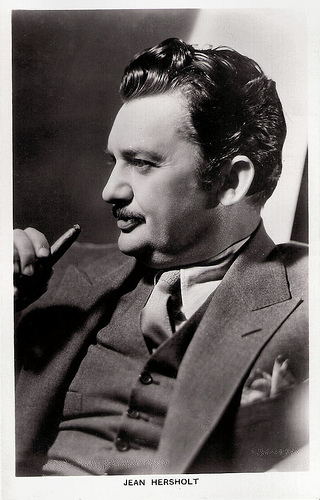
British postcard in the Picturegoer series, London, no. 360a.
Shirley Temple's beloved grandfather
Jean Hersholt’s best remembered film role is possibly Shirley Temple's beloved grandfather in Heidi (Allan Dwan, 1937), a film version of the 1880 children's book written by Swiss author Johanna Spyri. The film was a success and Temple enjoyed her third year in a row as number one box office draw.
Later films include the mystery Mr. Moto in Danger Island (I. Leeds, 1939), starring Peter Lorre .
In 1939, Jean Hersholt helped form the Motion Picture Relief Fund to support industry employees with medical care when they were down on their luck. The fund was used to create the Motion Picture Country House and Hospital in Woodland Hills, California, and it led to the creation in 1956 of the Jean Hersholt Humanitarian Award, an honorary Academy Award given to an "individual in the motion picture industry whose humanitarian efforts have brought credit to the industry”.
From 1945 till 1949, Hersholt was the President of the Academy of Motion Picture Arts and Sciences. During his long career in the cinema, his roles ranged from early silent villains to secondary parts in which his mild Danish accent and pleasant voice suited him to depict a succession of benevolent fathers, doctors, professors, and European noblemen.
Hersholt's last role was in Run for Cover (Nicholas Ray, 1955) with James Cagney and Viveca Lindfors .
Jean Hersholt translated over 160 of Andersen's fairy tales into the English language. These were published in 1949 in six volumes as The Complete Andersen. His large collection of Hans Christian Andersen books is now in the Library of Congress.
Hersholt was lauded with three Academy Awards for his own charity work, and in 1948, he was knighted by King Christian X of Denmark.
In 1914, Hersholt had married his wife Vita. They had two sons, Jean Hersholt Jr. and Allan Hersholt. He was the paternal half-uncle of the late actor Leslie Nielsen and former Canadian Deputy Prime Minister Erik Nielsen.
In 1956, Jean Hersholt died of cancer in Hollywood at the age of 69. He is interred in Forest Lawn Memorial Park Cemetery in Glendale, California. His grave is marked with a statue of Klods-Hans (Clumsy Hans), a Hans Christian Andersen character who left home to find his way in the world — much as Hersholt himself had done.
The last fight scene in Greed (1924). Source: Cinema History (YouTube).
Trailer Grand Hotel (1932). Source: Old School Trailers (YouTube).
Sources: (IMDb), Hal Erickson (AllMovie), Wikipedia and .

British postcard in the Picturegoer series, London, no. 360.

German postcard by Ross Verlag, no. 7244/1, 1932-1933, distributed in Italy by Casa Editrice Ballerini & Fratini, Firenze. Photo: Metro-Goldwyn-Mayer. Publicity still for Grand Hotel (Edmund Goulding, 1932).
The slimiest and most monstrous of movie villains
Jean Buron Hersholt (sources differ about his middle name) was born in Copenhagen, Denmark, in 1886. His father was a cigar salesman and his mother a singing girl. He graduated from the Copenhagen Art School.
His first three short films were made for the Nordisk Film Kompagni in Denmark in 1906. These were Professorens Morgenavis/Professor's morning newspaper (Louis Halberstadt, Viggo Larsen, 1906) with Max Freitag, Konfirmanden/Confirmand (Louis Halberstadt, 1906) and En ny hat til Madammen/A New Hat for Madam (Viggo Larsen, 1906).
He emigrated to the US in 1913, and the remainder of his films were made in America. He was an extra in early silent films Westerns like The Disciple (William S. Hart, 1915), Hell's Hinges (Charles Swickard, William S. Hart and Clifford Smith, 1916) and The Aryan (William S. Hart, 1916), both starring William S. Hart and produced by Thomas H. Ince. He played a priest in the silent Western The Soul Herder (John Ford, 1917) featuring Harry Carey.
By the 1920s his roles were substantial feature pieces, but most of these were as villains. Hal Erickson at AllMovie : “Hersholt was firmly entrenched as the slimiest and most monstrous of movie villains.”
He had one of his first leading roles as the servant in the silent drama The Servant in the House (Jack Conway, 1921) based on a 1908 Broadway play, The Servant in the House by Charles Rann Kennedy. The film was already shot in 1918 by the historic Triangle Film Corporation, but by 1920, Triangle had gone out of business. The film had a limited release in mid-1920 and was acquired by a different distributor in late 1920 for re-release in 1921. Then followed supporting parts in films like the drama Jazzmania (Robert Z. Leonard, 1923) starring Mae Murray.
Hersholt's best-remembered silent film is Greed (Erich von Stroheim, 1924) based on the 1899 Frank Norris novel McTeague. It stars Gibson Gowland as Dr. John McTeague, ZaSu Pitts as Trina Sieppe, his wife, and Hersholt as McTeague's friend and eventual enemy Marcus Schouler. Greed was one of the few films of its time to be shot entirely on location, with Von Stroheim shooting approximately 85 hours of footage before editing. Two months alone were spent shooting in Death Valley for the film's final sequence, and many of the cast and crew became ill.
According to William McPeak at IMDb , Hersholt endured the heat like a veteran but required a hospital stay after sweating away 27 pounds. Von Stroheim used sophisticated filming techniques such as deep-focus cinematography and montage editing. He considered Greed to be a Greek tragedy, in which environment and heredity controlled the characters' fates and reduced them to primitive bête humaines (human beasts). Greed was a critical and financial failure upon its initial release, but by the 1950s it began to be regarded as one of the greatest films ever made.
In the silent drama Stella Dallas (Henry King, 1925), Hersholt co-starred with Ronald Colman , Belle Bennett and Douglas Fairbanks Jr. Other silent films were My Old Dutch (Laurence Trimble, 1926), the crime drama The Old Soak (Edward Sloman, 1926) and Alias the Deacon (Edward Sloman, 1927).
Ernst Lubitsch directed him in The Student Prince in Old Heidelberg (1927) as the tutor of Ramón Novarro . Though now considered a classic by many film historians, it was far from a unanimous critical success during its original theatrical run.
In the silent romantic-comedy 13 Washington Square (Melville W. Brown, 1928) he starred with Alice Joyce and ZaSu Pitts, and in The Secret Hour (Rowland V. Lee, 1928) with Pola Negri . He was directed by legendary D.W. Griffith in the comedy The Battle of the Sexes (1928) a remake by Griffith of an earlier film he directed in 1914, which starred Lillian Gish . The film was released as both a silent film, and in a sound version using the Movietone sound-on-film system. He then starred in the part-talkie drama The Younger Generation (1929) directed by Frank Capra.

Spanish card by La Novela Semanal Cinematográfica, no. 372.

German postcard by Ross Verlag, no. 98/2. Photo: Metro-Goldwyn-Mayer. Publicity still for The Student Prince of Old Heidelberg (Ernst Lubitsch, 1927) with Ramón Novarro .
A camera friendly presence
Jean Hersholt’s first all mono sound film was The Climax (Renaud Hoffman, 1930) with Kathryn Crawford as a young Italian girl who wants to become a great opera singer. Despite his Danish accent, Hersholt had a pleasant, mellow voice and a camera friendly presence that ensured him continued success.
He co-starred in the action-adventure The Third Alarm (Emory Johnson, 1930) with Anita Louise and produced and released by Tiffany Pictures, a faltering B movie silent studio that tried to become a major.
For United Artists he co-starred with Lupe Velez in Hell Harbor (Henry King, 1930) and for MGM with Greta Garbo and Clark Gable in Susan Lenox (Her Fall and Rise) (Robert Z. Leonard, 1931). He supported Boris Karloff and Myrna Loy in The Mask of Fu Manchu (Charles Brabin, 1932), and Marie Dressler and Jean Harlow in Dinner at Eight (George Cukor, 1933).
He played Senf, the porter, in Grand Hotel (Edmund Goulding, 1932), also with Greta Garbo , and reunited with Clark Gable in Men in White (Ryszard Bolesławski, 1934).
In The Country Doctor (Henry King, 1936), starring the Canadian Dionne quintuplets, Hersholt portrayed Dr. John Luke, a character based on Dr. Allan Roy Dafoe, the obstetrician who delivered and cared for the Dionne quintuplets. Two sequels followed.
Hersholt wanted to do the role on radio, but could not get the rights. He decided to create his own doctor character for radio, and since he was a Hans Christian Andersen enthusiast, he borrowed that name for his character of the philosophical Dr. Paul Christian who practised in the Midwest town of River's End with the assistance of Nurse Judy Price.
Dr. Christian was introduced on CBS in 1937. The radio series became a popular long-running hit, continuing on CBS until 6 January 1954, with Hersholt so strongly identified with the role that he received mail asking for medical advice. Various spin-offs were produced, as Hersholt co-wrote a Dr. Christian novel and made a series of six family films as Christian from 1939 to 1941, for instance Dr. Christian Meets the Women in 1940. In 1956, his Dr. Christian character made the transition to television, scripted by Gene Roddenberry, with Macdonald Carey as his nephew.

British postcard in the Picturegoer series, London, no. 360a.
Shirley Temple's beloved grandfather
Jean Hersholt’s best remembered film role is possibly Shirley Temple's beloved grandfather in Heidi (Allan Dwan, 1937), a film version of the 1880 children's book written by Swiss author Johanna Spyri. The film was a success and Temple enjoyed her third year in a row as number one box office draw.
Later films include the mystery Mr. Moto in Danger Island (I. Leeds, 1939), starring Peter Lorre .
In 1939, Jean Hersholt helped form the Motion Picture Relief Fund to support industry employees with medical care when they were down on their luck. The fund was used to create the Motion Picture Country House and Hospital in Woodland Hills, California, and it led to the creation in 1956 of the Jean Hersholt Humanitarian Award, an honorary Academy Award given to an "individual in the motion picture industry whose humanitarian efforts have brought credit to the industry”.
From 1945 till 1949, Hersholt was the President of the Academy of Motion Picture Arts and Sciences. During his long career in the cinema, his roles ranged from early silent villains to secondary parts in which his mild Danish accent and pleasant voice suited him to depict a succession of benevolent fathers, doctors, professors, and European noblemen.
Hersholt's last role was in Run for Cover (Nicholas Ray, 1955) with James Cagney and Viveca Lindfors .
Jean Hersholt translated over 160 of Andersen's fairy tales into the English language. These were published in 1949 in six volumes as The Complete Andersen. His large collection of Hans Christian Andersen books is now in the Library of Congress.
Hersholt was lauded with three Academy Awards for his own charity work, and in 1948, he was knighted by King Christian X of Denmark.
In 1914, Hersholt had married his wife Vita. They had two sons, Jean Hersholt Jr. and Allan Hersholt. He was the paternal half-uncle of the late actor Leslie Nielsen and former Canadian Deputy Prime Minister Erik Nielsen.
In 1956, Jean Hersholt died of cancer in Hollywood at the age of 69. He is interred in Forest Lawn Memorial Park Cemetery in Glendale, California. His grave is marked with a statue of Klods-Hans (Clumsy Hans), a Hans Christian Andersen character who left home to find his way in the world — much as Hersholt himself had done.
The last fight scene in Greed (1924). Source: Cinema History (YouTube).
Trailer Grand Hotel (1932). Source: Old School Trailers (YouTube).
Sources: (IMDb), Hal Erickson (AllMovie), Wikipedia and .
Published on April 27, 2018 22:00
April 26, 2018
Vettori
Ed. G. Vettori published thousands of film star postcards during the 1920s. The Italian publisher, based in Bologna, made black and white postcards of both film stills and studio portraits and the subjects were national film actors but also international stars. For this post we chose both cards with famous Hollywood stars like Rudolph Valentino as well as with less know Italian actors like Nerio Bernardi and Renzo Ricci.
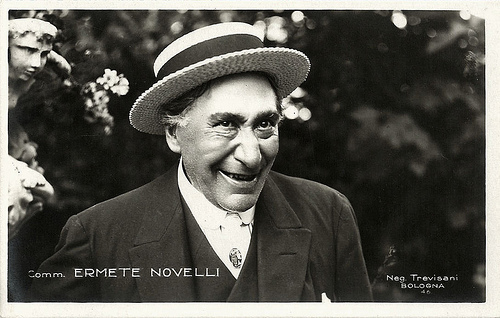
Ermete Novelli. Italian postcard by Ed. Vettori, Bologna, no. 46. Photo: Trevisani, Bologna.
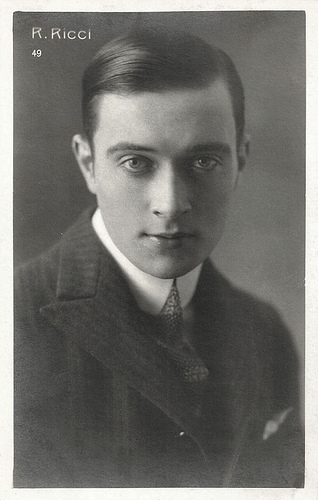
Renzo Ricci . Italian postcard by Vettori, Bologna, no. 49.

Francesca Bertini . Italian postcard by G. Vettori, Bologna, no. 136.
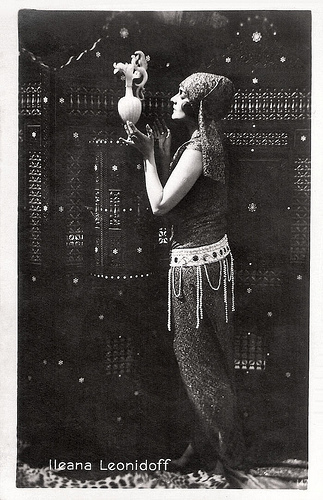
Ileana Leonidoff . Italian postcard by Vettori, Bologna, no. 147.
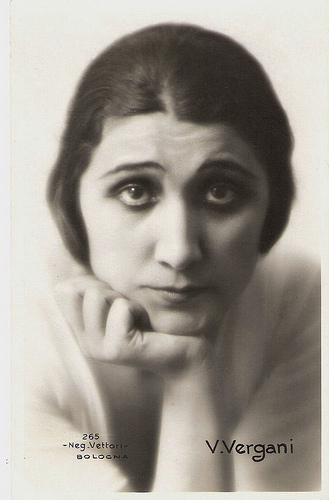
Vera Vergani . Italian postcard by Vettori, Bologna, no. 265.
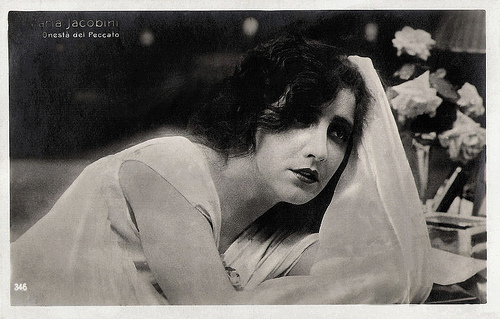
Maria Jacobini. Italian postcard by Vettori, Bologna, no. 346. Sent by mail in 1926. Photo: Maria Jacobini in Onestà del Peccato/The Wife He Neglected (Augusto Genina, 1918).
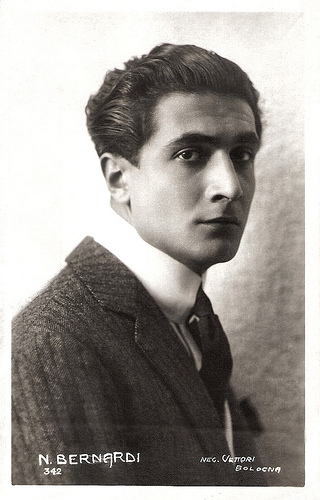
Nerio Bernardi. Italian postcard by Vettori, Bologna, no. 342.
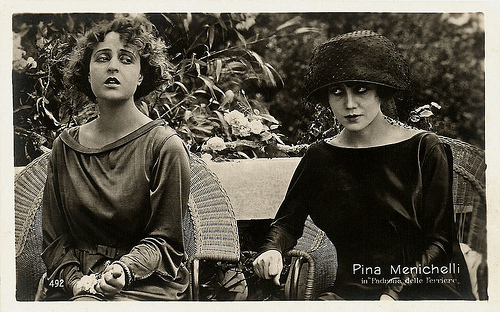
Pina Menichelli . Italian postcard by Vettori, Bologna, no. 492. Photo: publicity still for Il padrone delle ferriere/The Owner of the Ironworks (Eugenio Perego, 1919).
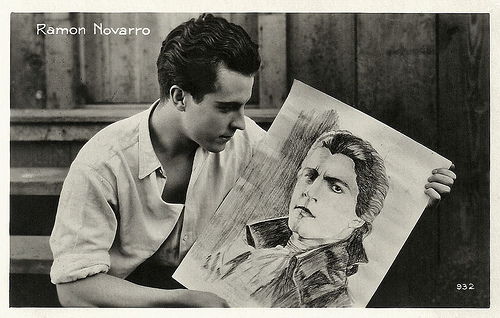
Ramon Novarro . Italian postcard by Vettori, Bologna, no. 932. Photo: the Mexican-American actor holding a sketch for the period piece Scaramouche (Rex Ingram, 1923), in which Novarro had the title role. The film, produced by Metro Pictures, was based on a novel by Rafaele Sabatini, and co-starred Alice Terry and Lewis Stone.
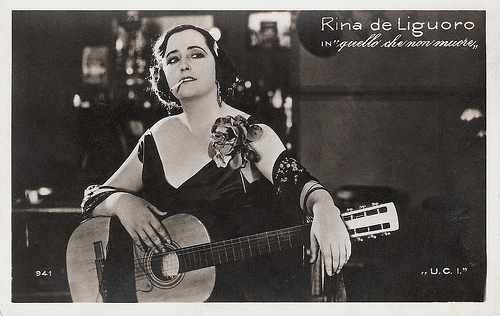
Rina de Liguoro . Italian postcard by G. Vettori, Bologna, no. 941. Photo: U.C.I. Publicity still for Quello che non muore/What does not die (Wladimiro De Liguoro, 1926).
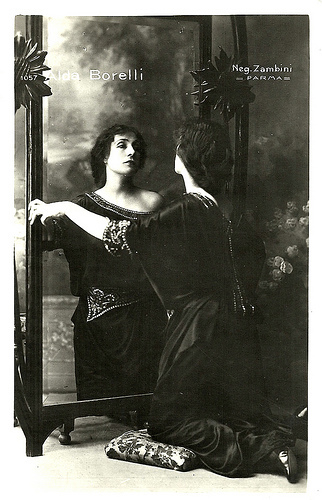
Alda Borelli . Italian postcard by Vettori, Bologna, no. 1057. Photo: Zambini, Parma.
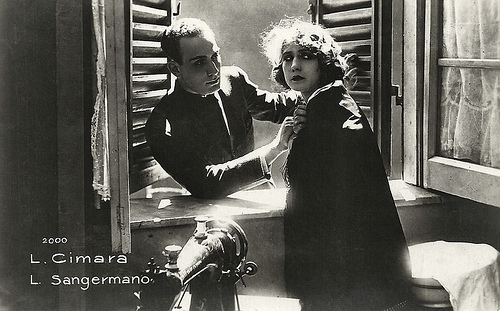
Italian postcard by G. Vettori, Bologna, no. 2000. Photo: Lucy Sangermano and Luigi Cimara acted twice together, in ...E dopo? (Febo Mari, 1918) and La rupe tarpea (Gaston Ravel, 1920).
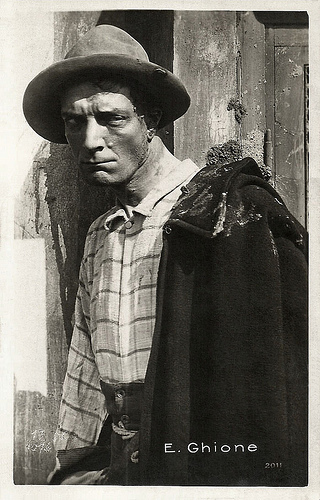
Emilio Ghione . Italian postcard by Vettori, Bologna, no. 2011. Emilio Ghione as Za-la-Mort.
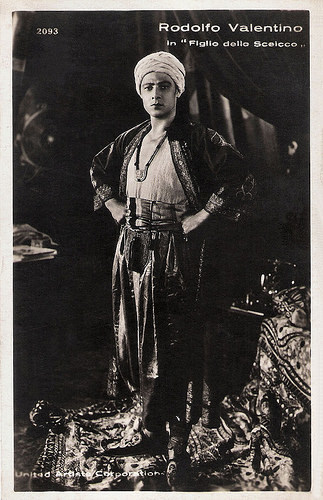
Rudolph Valentino . Italian postcard by Vettori, Bologna, no. 2093. Photo: United Artists. Publicity still for The Son of the Sheik (George Fitzmaurice, 1926).
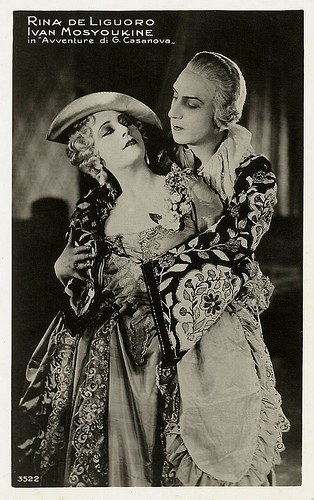
Rina De Liguoro & Ivan Mozzhukhin . Italian postcard by Vettori, Bologna, no. 3522. Photo: publicity still for Casanova (Alexandre Volkoff, 1927).

Ermete Novelli. Italian postcard by Ed. Vettori, Bologna, no. 46. Photo: Trevisani, Bologna.

Renzo Ricci . Italian postcard by Vettori, Bologna, no. 49.

Francesca Bertini . Italian postcard by G. Vettori, Bologna, no. 136.

Ileana Leonidoff . Italian postcard by Vettori, Bologna, no. 147.

Vera Vergani . Italian postcard by Vettori, Bologna, no. 265.

Maria Jacobini. Italian postcard by Vettori, Bologna, no. 346. Sent by mail in 1926. Photo: Maria Jacobini in Onestà del Peccato/The Wife He Neglected (Augusto Genina, 1918).

Nerio Bernardi. Italian postcard by Vettori, Bologna, no. 342.

Pina Menichelli . Italian postcard by Vettori, Bologna, no. 492. Photo: publicity still for Il padrone delle ferriere/The Owner of the Ironworks (Eugenio Perego, 1919).

Ramon Novarro . Italian postcard by Vettori, Bologna, no. 932. Photo: the Mexican-American actor holding a sketch for the period piece Scaramouche (Rex Ingram, 1923), in which Novarro had the title role. The film, produced by Metro Pictures, was based on a novel by Rafaele Sabatini, and co-starred Alice Terry and Lewis Stone.

Rina de Liguoro . Italian postcard by G. Vettori, Bologna, no. 941. Photo: U.C.I. Publicity still for Quello che non muore/What does not die (Wladimiro De Liguoro, 1926).

Alda Borelli . Italian postcard by Vettori, Bologna, no. 1057. Photo: Zambini, Parma.

Italian postcard by G. Vettori, Bologna, no. 2000. Photo: Lucy Sangermano and Luigi Cimara acted twice together, in ...E dopo? (Febo Mari, 1918) and La rupe tarpea (Gaston Ravel, 1920).

Emilio Ghione . Italian postcard by Vettori, Bologna, no. 2011. Emilio Ghione as Za-la-Mort.

Rudolph Valentino . Italian postcard by Vettori, Bologna, no. 2093. Photo: United Artists. Publicity still for The Son of the Sheik (George Fitzmaurice, 1926).

Rina De Liguoro & Ivan Mozzhukhin . Italian postcard by Vettori, Bologna, no. 3522. Photo: publicity still for Casanova (Alexandre Volkoff, 1927).
Published on April 26, 2018 22:00
April 25, 2018
Warwick Ward
Handsome English actor Warwick Ward (1889–1967) appeared in 64 British, American, German as well as French films between 1919 and 1933. These included such silent masterpieces as Madame Sans-Gene (1925) and Varieté/Variety (1925). He also produced 19 British films between 1931 and 1958.
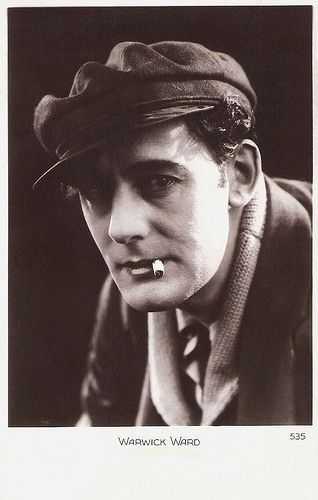
French postcard by Cinémagazine-Edition, Paris, no. 535.
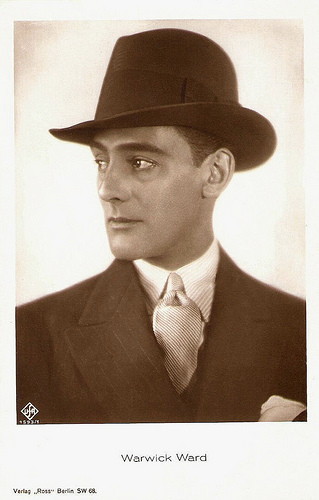
German postcard by Ross Verlag, Berlin, no. 1583/1, 1927-1928. Photo: UFA.
Villainous
Warwick Manson Ward was born in St. Ives, England, in 1889 (some sources say 1891). He made his stage debut in 1907, and had soon success in classical roles.
During the early 1920s he appeared in several silent British films. His film debut was the sports drama The Silver Lining (A.E Coleby, 1919). The following year he played in the Emily Brönte adaptation Wuthering Heights (A.V. Bramble, 1920) starring Milton Rosmer as Heathcliff and Colette Brettel as Cathy.
He appeared with Victor McLaglen in The Call of the Road (A.E. Coleby, 1920) and in Corinthian Jack (W. Courtney Rowden, 1921), with Henry Ainley in Build Thy House (Fred Goodwins, 1920), and with Milton Rosmer and Evelyn Brent in the drama Demos (Denison Clift, 1921), which is considered now to be lost.
That year he also appeared in Belphegor the Mountebank (Bert Wynne, 1921), a British silent film starring Milton Rosmer. It was based on the play Belphegor, the mountebank: or, Woman's constancy (ca. 1850) by Charles Webb about a nobleman who is forced to take up the life of a travelling showman. Another lost film is the drama Tell Your Children (Donald Crisp, 1922) for which Alfred Hitchcock is credited as the title designer.
That year Ward also appeared in the British-Dutch action film Bulldog Brummond (Oscar Apfel, 1922). Hal Erickson writes at AllMovie : “Filmed in England, this first movie version of the stage melodrama Bulldog Drummond featured a miscast Carlyle Blackwell in the title role. Captain Hugh ‘Bulldog’ Drummond, the soldier of fortune created by ‘Sapper’ (H.C. McNeile), was a combination old-school-tie British gentleman and brutish fascist. Blackwell could handle the ‘gentleman’ part, but wasn't quite up to the tough, two-fisted aspects of the character. Still, the story itself is a good one: Bored by inactivity, Drummond advertises for ‘adventure’ in the Times, and gets adventure aplenty when he becomes involved with a plot to kidnap an industrialist. The film's tension highlight was the scene in which the villainous Lakington (Warwick Ward) taunts a bound Drummond by fondling unconscious heroine Phyllis Benton (Evelyn Greeley)”.
Ward then starred opposite Violet Hopson in the sports films The Lady Owner (Walter West, 1923) and The Great Turf Mystery (Walter West, 1924), opposite Lillian Hall-Davis in the crime drama The Hotel Mouse (Fred Paul, 1923) and opposite Betty Blythe in Southern Love/A Woman's Secret (Herbert Wilcox, 1924). The latter was based on the poem The Spanish Student by Henry Wadsworth Longfellow about the young gypsy Dolores, who escapes from an arranged marriage and makes a living as a dancer.
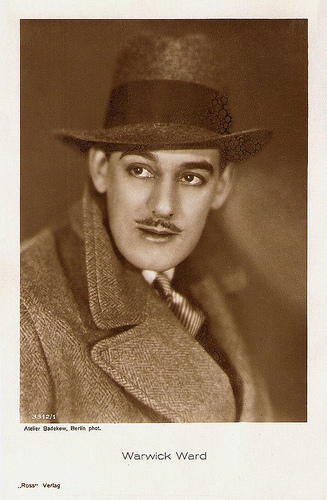
German postcard by Ross Verlag, Berlin, no. 3312/1, 1928-1929. Photo: Atelier Badekow, Berlin.
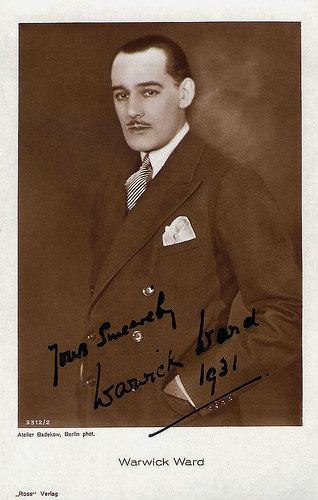
German postcard by Ross Verlag, no. 3312/2, 1928-1929. Signed in 1931. Photo: Atelier Badekow, Berlin.
In Europe’s Film Capital
Warwick Ward moved to France to appear opposite Hollywood diva Gloria Swanson in Madame Sans-Gene (Léonce Perret, 1925), a silent Famous Players-Lasky production by Jesse L. Lasky and Adolph Zukor. Swanson made this romantic comedy/costume drama while on an extended vacation. She helped to secure many of the filming locations (Chateau Fontainebleau, for example) herself. Soon she became involved with her interpreter Henri de la Falaise, a Marquis, although he was not very wealthy. He later became her third husband. Before her death, Swanson yearned to see this film. She considered it as her best work, but sadly the film is lost.
After this Paris adventure, Ward moved to Europe’s film capital at the time, Berlin. There he played in another silent classic, Varieté/Variety (Ewald Andre Dupont, 1925), based on the novel Der Eid des Stephan Huller (The Oath of Stephan Huller, 1923) by Felix Hollaender. The film tells the story of a carnival concessionaire (Emil Jannings), his alluring girlfriend ( Lya de Putti ), and the handsome acrobat (Warwick Ward) who comes between them.
Feeling doubly impotent because he himself had been a famous aerialist before suffering a crippling accident, Jannings fantasises about killing his rival - and, finally, does so. The trapeze scenes were set in the Berlin Wintergarten theatre and camera man Karl Freund let the camera swing from long shot to close-up, like the acrobats. The results astounded international audiences.
Ward stayed in Germany for such silent films as Die Fahrt ins Abenteuer/The Wooing of Eve (Max Mack, 1926) with Ossi Oswalda, the UFA adventure film Die Frauengasse von Algier/Streets of Algiers (Wolfgang Hoffmann-Harnisch, 1927) with Maria Jacobini and Camilla Horn , and Die berühmte Frau/The Famous Woman (Robert Wiene, 1927) with Lily Damita .
One of his best late silent films is the circus melodrama Die Todesschleife/Looping the Loop (Arthur Robison, 1928) starring Werner Krauss as a clown with Ward (again) as the handsome acrobat who steals the clown’s pretty girl ( Jenny Jugo ).
Another masterpiece was Die wunderbare Lüge der Nina Petrowna/The Wonderful Lie of Nina Petrovna (Hanns Schwarz, 1929) starring Brigitte Helm and Franz (Francis) Lederer . Meanwhile Ward also continued to make silent films in France and Great-Britain.
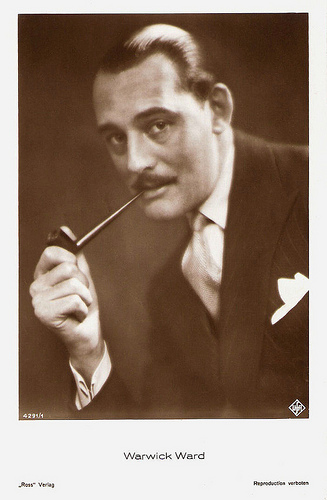
German postcard by Ross Verlag, Berlin, no. 4291/1, 1927-1928. Photo: UFA.
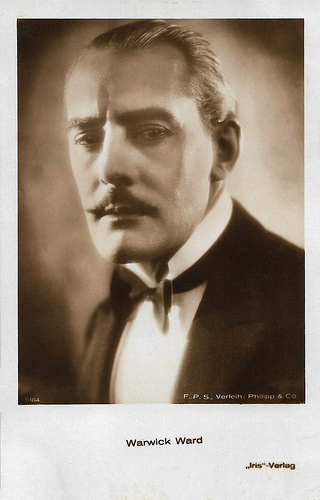
Austrian postcard by Iris-Verlag, no. 6164. Photo: F.P.S. Verleih: Philipp & Co.
The Dancing Years
After the arrival of the sound film in Germany, Warwick Ward had to return to Great Britain. There he appeared opposite Pola Negri in the late silent film-with-sound-effects The Way of Lost Souls (Paul Czinner, 1929).
He reunited with Lya de Putti for the British sound drama The Informer (Arthur Robison, 1929). Hungarian De Putti's voice was dubbed – not with an Irish accent, as the character called for, but, for some reason, with an upper-class English accent. The film was based on the novel The Informer by Liam O'Flaherty which was again adapted in 1935 by John Ford.
In the British musical comedy A Man of Mayfair (Louis Mercanton, 1931), Ward starred with Jack Buchanan, and in The Loves of Ariane (Paul Czinner, 1931) his co-star was Elisabeth Bergner . He appeared in a few more supporting parts, such as in the English version of the German world success F.P.1/ F. P. 1 Doesn't Answer (Karl Hartl, 1933) starring Conrad Veidt .
But his acting days were over. A few years earlier, Ward had started to produce films, and in the following years he would produce such British comedies as Save a Little Sunshine (Norman Lee, 1938) starring Dave Willis and Patricia Kirkwood, about a man who buys a share in a hotel after he is sacked from his job. The film was made by Welwyn Studios, an affiliate of ABC Pictures, at their Welwyn Garden City Studio.
He also produced a further film with Willis and Kirkwood, Me and My Pal (Thomas Bentley, 1939). During the war years he produced for Welwyn such crime thrillers as Suspected Person (Lawrence Huntington) with Patricia Roc . After the war he returned to comedies, which he now produced for Associated British Picture Corporation (ABPC).
Among them are Quiet Weekend (Harold French, 1946) with Derek Farr, and The Dancing Years (Harold French, 1950) starring Dennis Price .
Warwick Ward continued to produce films till 1958. He died in 1967 in Welwyn Garden City, near London, at the age of 78.
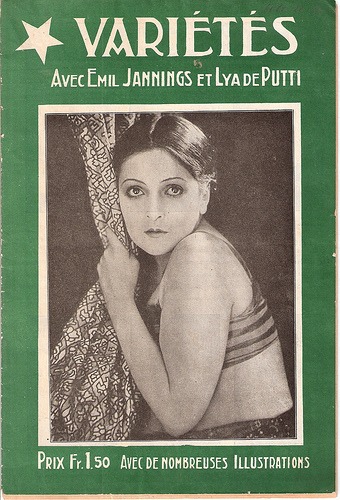
Belgium brochure by Patria editions, Antwerp for Varieté (Ewald André Dupont, 1925) with Lya de Putti on the cover.
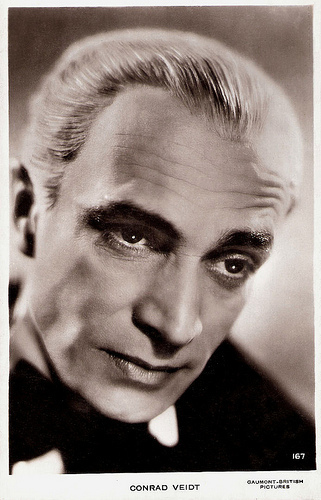
Conrad Veidt . British postcard by Real Photograph, no. 167. Photo: Gaumont-British Pictures.
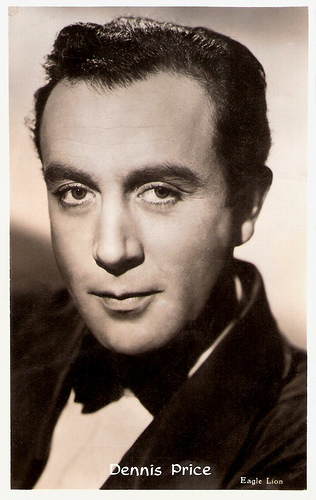
Dennis Price . Dutch postcard. Photo: Eagle Lion.
Sources: Hal Erickson (AllMovie), Thomas Staedeli (Cyranos), Wikipedia (English and German) and .

French postcard by Cinémagazine-Edition, Paris, no. 535.

German postcard by Ross Verlag, Berlin, no. 1583/1, 1927-1928. Photo: UFA.
Villainous
Warwick Manson Ward was born in St. Ives, England, in 1889 (some sources say 1891). He made his stage debut in 1907, and had soon success in classical roles.
During the early 1920s he appeared in several silent British films. His film debut was the sports drama The Silver Lining (A.E Coleby, 1919). The following year he played in the Emily Brönte adaptation Wuthering Heights (A.V. Bramble, 1920) starring Milton Rosmer as Heathcliff and Colette Brettel as Cathy.
He appeared with Victor McLaglen in The Call of the Road (A.E. Coleby, 1920) and in Corinthian Jack (W. Courtney Rowden, 1921), with Henry Ainley in Build Thy House (Fred Goodwins, 1920), and with Milton Rosmer and Evelyn Brent in the drama Demos (Denison Clift, 1921), which is considered now to be lost.
That year he also appeared in Belphegor the Mountebank (Bert Wynne, 1921), a British silent film starring Milton Rosmer. It was based on the play Belphegor, the mountebank: or, Woman's constancy (ca. 1850) by Charles Webb about a nobleman who is forced to take up the life of a travelling showman. Another lost film is the drama Tell Your Children (Donald Crisp, 1922) for which Alfred Hitchcock is credited as the title designer.
That year Ward also appeared in the British-Dutch action film Bulldog Brummond (Oscar Apfel, 1922). Hal Erickson writes at AllMovie : “Filmed in England, this first movie version of the stage melodrama Bulldog Drummond featured a miscast Carlyle Blackwell in the title role. Captain Hugh ‘Bulldog’ Drummond, the soldier of fortune created by ‘Sapper’ (H.C. McNeile), was a combination old-school-tie British gentleman and brutish fascist. Blackwell could handle the ‘gentleman’ part, but wasn't quite up to the tough, two-fisted aspects of the character. Still, the story itself is a good one: Bored by inactivity, Drummond advertises for ‘adventure’ in the Times, and gets adventure aplenty when he becomes involved with a plot to kidnap an industrialist. The film's tension highlight was the scene in which the villainous Lakington (Warwick Ward) taunts a bound Drummond by fondling unconscious heroine Phyllis Benton (Evelyn Greeley)”.
Ward then starred opposite Violet Hopson in the sports films The Lady Owner (Walter West, 1923) and The Great Turf Mystery (Walter West, 1924), opposite Lillian Hall-Davis in the crime drama The Hotel Mouse (Fred Paul, 1923) and opposite Betty Blythe in Southern Love/A Woman's Secret (Herbert Wilcox, 1924). The latter was based on the poem The Spanish Student by Henry Wadsworth Longfellow about the young gypsy Dolores, who escapes from an arranged marriage and makes a living as a dancer.

German postcard by Ross Verlag, Berlin, no. 3312/1, 1928-1929. Photo: Atelier Badekow, Berlin.

German postcard by Ross Verlag, no. 3312/2, 1928-1929. Signed in 1931. Photo: Atelier Badekow, Berlin.
In Europe’s Film Capital
Warwick Ward moved to France to appear opposite Hollywood diva Gloria Swanson in Madame Sans-Gene (Léonce Perret, 1925), a silent Famous Players-Lasky production by Jesse L. Lasky and Adolph Zukor. Swanson made this romantic comedy/costume drama while on an extended vacation. She helped to secure many of the filming locations (Chateau Fontainebleau, for example) herself. Soon she became involved with her interpreter Henri de la Falaise, a Marquis, although he was not very wealthy. He later became her third husband. Before her death, Swanson yearned to see this film. She considered it as her best work, but sadly the film is lost.
After this Paris adventure, Ward moved to Europe’s film capital at the time, Berlin. There he played in another silent classic, Varieté/Variety (Ewald Andre Dupont, 1925), based on the novel Der Eid des Stephan Huller (The Oath of Stephan Huller, 1923) by Felix Hollaender. The film tells the story of a carnival concessionaire (Emil Jannings), his alluring girlfriend ( Lya de Putti ), and the handsome acrobat (Warwick Ward) who comes between them.
Feeling doubly impotent because he himself had been a famous aerialist before suffering a crippling accident, Jannings fantasises about killing his rival - and, finally, does so. The trapeze scenes were set in the Berlin Wintergarten theatre and camera man Karl Freund let the camera swing from long shot to close-up, like the acrobats. The results astounded international audiences.
Ward stayed in Germany for such silent films as Die Fahrt ins Abenteuer/The Wooing of Eve (Max Mack, 1926) with Ossi Oswalda, the UFA adventure film Die Frauengasse von Algier/Streets of Algiers (Wolfgang Hoffmann-Harnisch, 1927) with Maria Jacobini and Camilla Horn , and Die berühmte Frau/The Famous Woman (Robert Wiene, 1927) with Lily Damita .
One of his best late silent films is the circus melodrama Die Todesschleife/Looping the Loop (Arthur Robison, 1928) starring Werner Krauss as a clown with Ward (again) as the handsome acrobat who steals the clown’s pretty girl ( Jenny Jugo ).
Another masterpiece was Die wunderbare Lüge der Nina Petrowna/The Wonderful Lie of Nina Petrovna (Hanns Schwarz, 1929) starring Brigitte Helm and Franz (Francis) Lederer . Meanwhile Ward also continued to make silent films in France and Great-Britain.

German postcard by Ross Verlag, Berlin, no. 4291/1, 1927-1928. Photo: UFA.

Austrian postcard by Iris-Verlag, no. 6164. Photo: F.P.S. Verleih: Philipp & Co.
The Dancing Years
After the arrival of the sound film in Germany, Warwick Ward had to return to Great Britain. There he appeared opposite Pola Negri in the late silent film-with-sound-effects The Way of Lost Souls (Paul Czinner, 1929).
He reunited with Lya de Putti for the British sound drama The Informer (Arthur Robison, 1929). Hungarian De Putti's voice was dubbed – not with an Irish accent, as the character called for, but, for some reason, with an upper-class English accent. The film was based on the novel The Informer by Liam O'Flaherty which was again adapted in 1935 by John Ford.
In the British musical comedy A Man of Mayfair (Louis Mercanton, 1931), Ward starred with Jack Buchanan, and in The Loves of Ariane (Paul Czinner, 1931) his co-star was Elisabeth Bergner . He appeared in a few more supporting parts, such as in the English version of the German world success F.P.1/ F. P. 1 Doesn't Answer (Karl Hartl, 1933) starring Conrad Veidt .
But his acting days were over. A few years earlier, Ward had started to produce films, and in the following years he would produce such British comedies as Save a Little Sunshine (Norman Lee, 1938) starring Dave Willis and Patricia Kirkwood, about a man who buys a share in a hotel after he is sacked from his job. The film was made by Welwyn Studios, an affiliate of ABC Pictures, at their Welwyn Garden City Studio.
He also produced a further film with Willis and Kirkwood, Me and My Pal (Thomas Bentley, 1939). During the war years he produced for Welwyn such crime thrillers as Suspected Person (Lawrence Huntington) with Patricia Roc . After the war he returned to comedies, which he now produced for Associated British Picture Corporation (ABPC).
Among them are Quiet Weekend (Harold French, 1946) with Derek Farr, and The Dancing Years (Harold French, 1950) starring Dennis Price .
Warwick Ward continued to produce films till 1958. He died in 1967 in Welwyn Garden City, near London, at the age of 78.

Belgium brochure by Patria editions, Antwerp for Varieté (Ewald André Dupont, 1925) with Lya de Putti on the cover.

Conrad Veidt . British postcard by Real Photograph, no. 167. Photo: Gaumont-British Pictures.

Dennis Price . Dutch postcard. Photo: Eagle Lion.
Sources: Hal Erickson (AllMovie), Thomas Staedeli (Cyranos), Wikipedia (English and German) and .
Published on April 25, 2018 22:00
April 24, 2018
Napoléon (1927)
Abel Gance’s epic film Napoléon (1927) is one of the masterpieces of the European silent cinema. Gance tells the story of the French general's youth and early military career in a massive, six-hour biopic. The film's legendary reputation is due to the astonishing range of techniques that Gance uses to tell his story, culminating in the final twenty-minute triptych sequence, which alternates wide screen panoramas with complex multiple-image montages projected simultaneously on three screens. And Albert Dieudonne was perfectly cast as Napoleon Bonaparte.
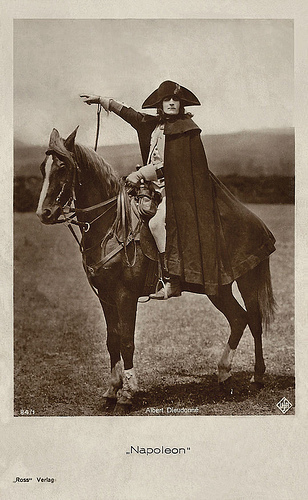
German postcard by Ross Verlag, no. 84/1, 1925-1935. Photo: Ufa. Albert Dieudonné as the title character in Abel Gance’s epic film Napoléon (1927).
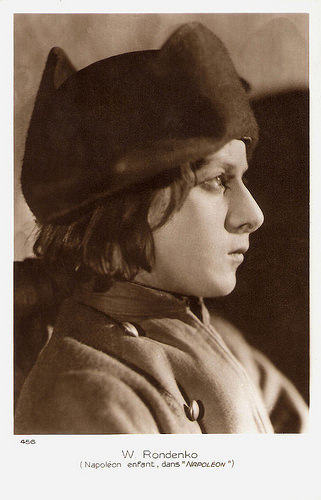
French postcard by Cinémagazine-Edition, no. 456. Photo: Vladimir Roudenko as the young Napoléon in Napoléon (Abel Gance, 1927).
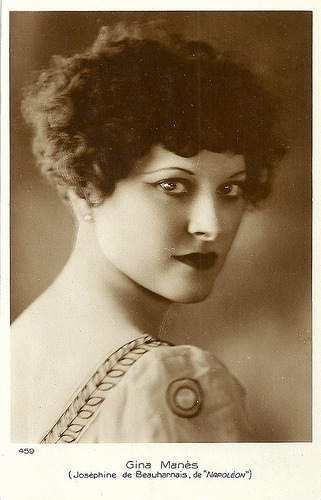
French postcard by Editions Cinémagazines, no. 459. Photo: Gina Manès as Josephine de Beauharnais in Napoléon (Abel Gance, 1927).
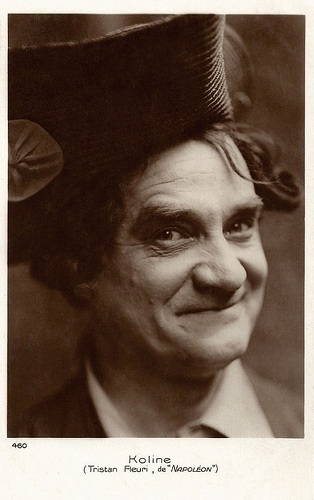
French postcard by Editions Cinémagazine, no. 460. Photo: Nicolas Koline as Tristan Fleuri in Napoléon (Abel Gance, 1927).
A chronology of great triumph and defeat
Napoléon (1927) begins in Brienne-le-Château with youthful Napoleon (Vladimir Roudenko) attending military school where he manages a snowball fight like a military campaign, yet he suffers the insults of other boys.
The film continues a decade later with scenes of the French Revolution and Napoleon's ( Albert Dieudonné ) presence at the periphery as a young army lieutenant. He returns to visit his family home in Corsica but politics shift against him and put him in mortal danger. He flees, taking his family to France.
Serving as an officer of artillery in the Siege of Toulon, Napoleon's genius for leadership is rewarded with a promotion to brigadier general. Jealous revolutionaries imprison Napoleon but then the political tide turns against the Revolution's own leaders. Napoleon leaves prison, forming plans to invade Italy.
He falls in love with the beautiful Joséphine de Beauharnais ( Gina Manès ). The emergency government charges him with the task of protecting the National Assembly. Succeeding in this he is promoted to Commander-in-Chief of the Army of the Interior, and he marries Joséphine. He takes control of the army which protects the French–Italian border, and propels it to victory in an invasion of Italy.
Many innovative techniques were used to make the film, including fast cutting, extensive close-ups, a wide variety of hand-held camera shots, location shooting, point of view shots, multiple-camera setups, multiple exposure, superimposition, underwater camera, kaleidoscopic images, film tinting, split screen and mosaic shots, multi-screen projection, and other visual effects.
Director, writer and producer Abel Gance planned for Napoléon to be the first of six films about Napoleon's career, a chronology of great triumph and defeat ending in Napoleon's death in exile on the island of Saint Helena. After the difficulties encountered in making the first film, Gance realised that the costs involved would make the full project impossible.
Napoléon was first released in a gala at the Palais Garnier (then the home of the Paris Opera) on 7 April 1927. Napoléon had been screened in only eight European cities when Metro-Goldwyn-Mayer bought the rights to it, but after screening it in London, it was cut drastically in length, and only the central panel of the three-screen Polyvision sequences was retained before it was put on limited release in the United States. There, the film was indifferently received at a time when talkies were just starting to appear.
The film was restored in 1981 after twenty years' work by silent film historian Kevin Brownlow.
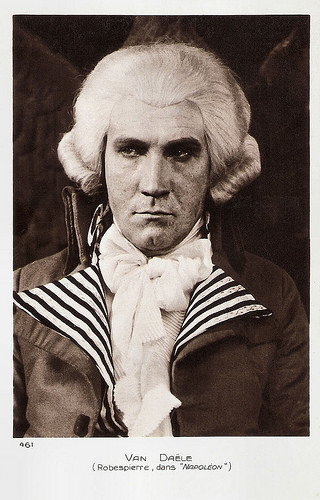
French postcard by Editions Cinémagazine, no. 461. Photo: Edmond Van Daële as Robespierre in Napoléon (Abel Gance, 1927).
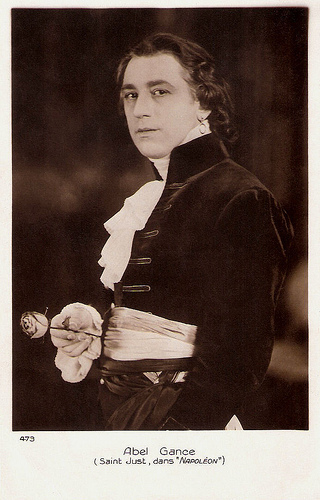
French postcard by Editions Cinémagazine, no. 473. Photo: publicity still for Napoléon (Abel Gance, 1927), with Abel Gance himself as Saint Just.
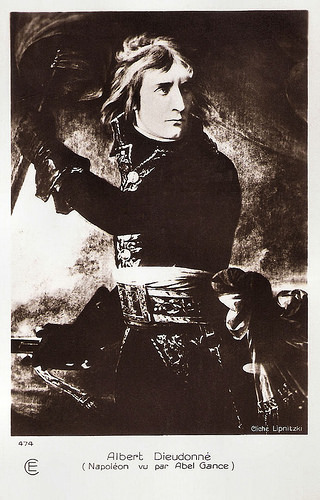
French postcard by Editions Cinémagazine, no. 474. Photo: Lipnitzky. Publicity still for Napoléon (Abel Gance, 1927), with Albert Dieudonné as Napoléon. The postcard is a pastiche of the famous portrait of Bonaparte at Arcole, 1796, by Baron Antoine-Jean Gros. See more.
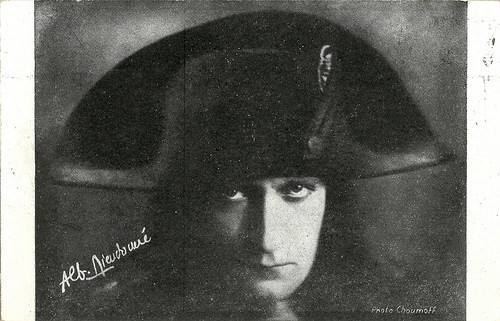
French postcard. Photo Choumoff. Albert Dieudonné as Napoleon. The retro of the card makes publicity for Dieudonné in a stage version 'Bonaparte' at the Theatre de la Renaissance.
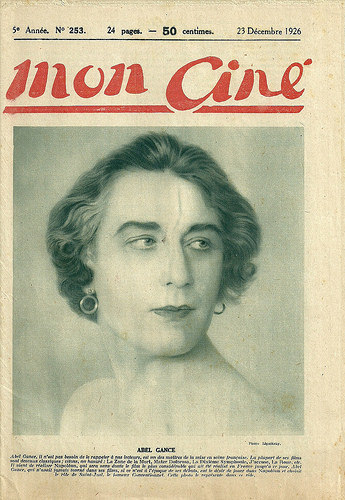
Director/actor Abel Gance on the cover of the French film journal Mon Ciné, no. 253, V, 23 December 1926. Gance is groomed as the character he played in Napoléon (1927), that of Saint-Just, one of the leading men of the French Terror.
Sources: Michael Brooke (IMDb), Wikipedia and IMDb.

German postcard by Ross Verlag, no. 84/1, 1925-1935. Photo: Ufa. Albert Dieudonné as the title character in Abel Gance’s epic film Napoléon (1927).

French postcard by Cinémagazine-Edition, no. 456. Photo: Vladimir Roudenko as the young Napoléon in Napoléon (Abel Gance, 1927).

French postcard by Editions Cinémagazines, no. 459. Photo: Gina Manès as Josephine de Beauharnais in Napoléon (Abel Gance, 1927).

French postcard by Editions Cinémagazine, no. 460. Photo: Nicolas Koline as Tristan Fleuri in Napoléon (Abel Gance, 1927).
A chronology of great triumph and defeat
Napoléon (1927) begins in Brienne-le-Château with youthful Napoleon (Vladimir Roudenko) attending military school where he manages a snowball fight like a military campaign, yet he suffers the insults of other boys.
The film continues a decade later with scenes of the French Revolution and Napoleon's ( Albert Dieudonné ) presence at the periphery as a young army lieutenant. He returns to visit his family home in Corsica but politics shift against him and put him in mortal danger. He flees, taking his family to France.
Serving as an officer of artillery in the Siege of Toulon, Napoleon's genius for leadership is rewarded with a promotion to brigadier general. Jealous revolutionaries imprison Napoleon but then the political tide turns against the Revolution's own leaders. Napoleon leaves prison, forming plans to invade Italy.
He falls in love with the beautiful Joséphine de Beauharnais ( Gina Manès ). The emergency government charges him with the task of protecting the National Assembly. Succeeding in this he is promoted to Commander-in-Chief of the Army of the Interior, and he marries Joséphine. He takes control of the army which protects the French–Italian border, and propels it to victory in an invasion of Italy.
Many innovative techniques were used to make the film, including fast cutting, extensive close-ups, a wide variety of hand-held camera shots, location shooting, point of view shots, multiple-camera setups, multiple exposure, superimposition, underwater camera, kaleidoscopic images, film tinting, split screen and mosaic shots, multi-screen projection, and other visual effects.
Director, writer and producer Abel Gance planned for Napoléon to be the first of six films about Napoleon's career, a chronology of great triumph and defeat ending in Napoleon's death in exile on the island of Saint Helena. After the difficulties encountered in making the first film, Gance realised that the costs involved would make the full project impossible.
Napoléon was first released in a gala at the Palais Garnier (then the home of the Paris Opera) on 7 April 1927. Napoléon had been screened in only eight European cities when Metro-Goldwyn-Mayer bought the rights to it, but after screening it in London, it was cut drastically in length, and only the central panel of the three-screen Polyvision sequences was retained before it was put on limited release in the United States. There, the film was indifferently received at a time when talkies were just starting to appear.
The film was restored in 1981 after twenty years' work by silent film historian Kevin Brownlow.

French postcard by Editions Cinémagazine, no. 461. Photo: Edmond Van Daële as Robespierre in Napoléon (Abel Gance, 1927).

French postcard by Editions Cinémagazine, no. 473. Photo: publicity still for Napoléon (Abel Gance, 1927), with Abel Gance himself as Saint Just.

French postcard by Editions Cinémagazine, no. 474. Photo: Lipnitzky. Publicity still for Napoléon (Abel Gance, 1927), with Albert Dieudonné as Napoléon. The postcard is a pastiche of the famous portrait of Bonaparte at Arcole, 1796, by Baron Antoine-Jean Gros. See more.

French postcard. Photo Choumoff. Albert Dieudonné as Napoleon. The retro of the card makes publicity for Dieudonné in a stage version 'Bonaparte' at the Theatre de la Renaissance.

Director/actor Abel Gance on the cover of the French film journal Mon Ciné, no. 253, V, 23 December 1926. Gance is groomed as the character he played in Napoléon (1927), that of Saint-Just, one of the leading men of the French Terror.
Sources: Michael Brooke (IMDb), Wikipedia and IMDb.
Published on April 24, 2018 22:00
April 23, 2018
Willi Domgraf Fassbaender
Celebrated German opera singer Willi Domgraf Fassbaender (1897–1978) was one of the leading lyric baritones of the inter-war period. He was particularly associated with Mozart and Italian roles. During the 1930s, ‘the Italian baritone’ starred in a number of musical films, which helped his shining international reputation.
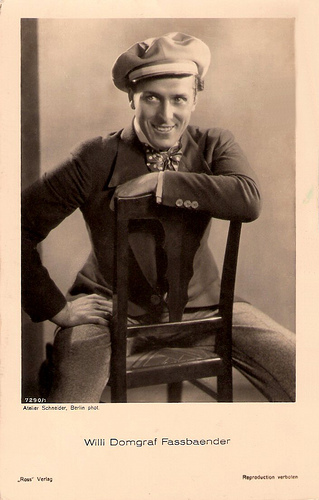
German postcard by Ross Verlag, no. 7290/1, 1932-1933 (sent by mail in the Netherlands in 1935). Photo: Atelier Schneider, Berlin.
Beautiful Voice
Willi Domgraf Fassbaender (also written as Willy Domgraf(-)Fassb(a)ender) was born in Aachen, Germany, in 1897.
Initially, he intended to become a conductor and musicologist for church music, but eventually he studied singing with Julius Stückgold. He had a beautiful voice and used it with fine musicianship.
He began his career as an oratorio and concert singer, but the director of the Stadttheater Aachen encouraged him to appear in opera and operetta. In 1922 he made his debut in Aachen as Count Almaviva in Le Nozze di Figaro.
In the following year, Leo Blech engaged him to the Deutsche Oper Berlin where the young singer continued his vocal studies with Paul Bruns. Due to strong competition, Domgraf-Fassbaender changed to the opera house in Düsseldorf, completing his studies with the famous Giuseppe Borgatti in Milan.
It was in Düsseldorf where he gained experience in an extensive repertoire: Figaro, Count Almaviva, Rigoletto, Wolfram, Papageno, Don Giovanni, et cetera. In 1927 he joined the company of the State Opera in Stuttgart, where he became one of its most popular singers.
It was Richard Tauber (his partner in La Bohème and Carmen) who recommended him to go back to Berlin. General manager Heinz Tietjen, who was to become his mentor, contracted him to the Berlin State Opera, where he gained quickly a reputation as ‘the Italian baritone’.
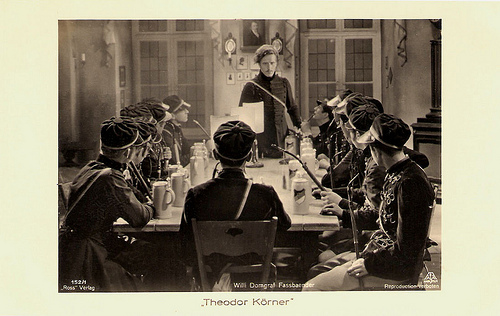
German postcard by Ross Verlag, no. 152/1. Photo: Aafa Film. Publicity still for Theodor Körner (Carl Boese, 1932).
Heydays of the German Film Musical
Willi Domgraf Fassbaender was an accomplished singer-actor, and his shining international reputation was helped by his starring in a number of musical films. In 1932, at the heydays of the German film musical, he made his film debut in Der Sieger/The Winner (Hans Hinrich, Paul Martin, 1932) with Hans Albers .
An adaptation of Friedrich Smetana’s opera Die Verkaufte Braut/The Bartered Bride (Max Ophüls, 1932) with the beautiful Jarmila Novotnà in the title role, gained world-wide success. He sang the role of Hans, which was originally meant for a tenor.
That same year he also appeared in the short film Goethe-Gedenkfilm - 1. Der Werdegang/Goethe Memorial Film, part 1 (Fritz Wendhausen, 1932), and in Theodor Körner (Carl Boese, 1932) with Dorothea Wieck .
Next he starred in Ich will Dich Liebe lehren/I Will Teach You to Love (Heinz Hilpert, 1933). He insisted on also playing in the alternate French version, L’homme qui ne sait pas dire non/The Man Who Doesn't Know to Say No, but his accent was so bad that this version was never released.
After the rise to power of the Nazis, he became a party member of the NSDAP in May 1933. The following years he was the star of Aufforderung zum Tanz/Invitation to the Dance (Rudolf van der Noss, 1933), Starke Herzen/Strong Hearts (Herbert Maisch, 1937), Ein Lied von Liebe/A Song of Love (Jürgen von Alten, 1938) in which he starred with his wife Sabine Peters, and Lauter Liebe/Pure Love (Heinz Rühmann, 1940) with Hertha Feiler .
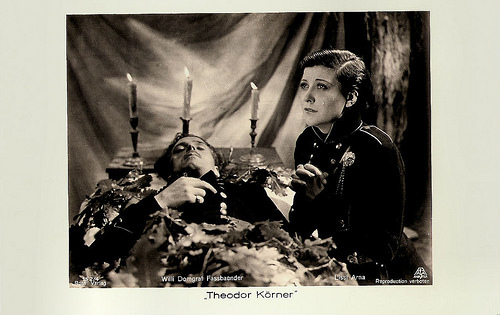
German postcard by Ross Verlag, no. 152/4. Photo: Aafa Film. Publicity still for Theodor Körner (Carl Boese, 1932) with Lizzy Arna.
Mozart
Willi Domgraf-Fassbaender’s devotion to modern works was quite remarkable (including operas by Malipiero, Wellesz, Schoeck), but his career was dominated by his Italian parts and Mozart.
Fritz Busch invited him to the Glyndebourne Festival, where he sang the Count in Le Nozze di Figaro as well as Guglielmo in Così fan tutte in the 1934, 1935 and 1939 series. In 1937 he was chosen by Arturo Toscanini to sing Papageno in Die Zauberflöte/The Magic Flute at the Salzburg Festival.
In 1942 he received the title of ‘Kammersänger'. After World War II, he performed mostly in Vienna, Munich, Hannover, and Nuremberg. At the Vienna State Opera, he sang Wolfram, Papageno and Ford.
His last film appearance was as Figaro in the DEFA production of Figaros Hochzeit/The Marriage of Figaro (Georg Wildhagen, 1949) with Angelika Hauff and Sabine Peters.
After 1951 Domgraf-Fassbaender worked as an outstanding stage director. In 1954 he went to the Conservatory of Nuremberg, where he led the opera school and taught a vocal class.
Willi Domgraf-Fassbaender died in 1978, in Nuremberg. His only daughter, from his marriage with Sabine Peters, was mezzo-soprano Brigitte Fassbaender (1939), who studied exclusively with her father and was to become a celebrated mezzo.
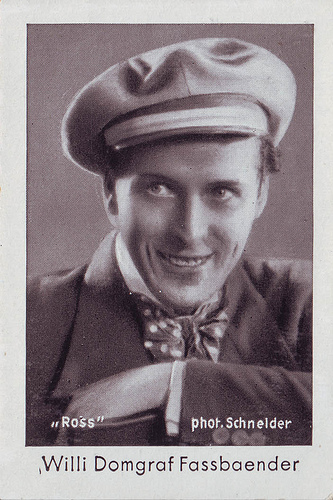
German collectors card by Ross, Haus Neueburg Film Album 2, no. 167. Photo: Schneider. Collection: Manuel Palomino Arjona (Flickr).
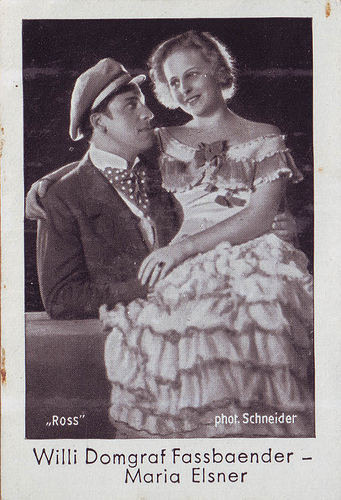
With Maria Elsner in a stage production. German collectors card by Ross, Haus Neueburg Film Album 2, no. 211. Photo: Schneider. Collection: Manuel Palomino Arjona (Flickr).
Sources: Andrea Suhm-Binder (subito – cantabile), Thomas Staedeli (Cyranos), Wikipedia (German and English), Filmportal.de, and .

German postcard by Ross Verlag, no. 7290/1, 1932-1933 (sent by mail in the Netherlands in 1935). Photo: Atelier Schneider, Berlin.
Beautiful Voice
Willi Domgraf Fassbaender (also written as Willy Domgraf(-)Fassb(a)ender) was born in Aachen, Germany, in 1897.
Initially, he intended to become a conductor and musicologist for church music, but eventually he studied singing with Julius Stückgold. He had a beautiful voice and used it with fine musicianship.
He began his career as an oratorio and concert singer, but the director of the Stadttheater Aachen encouraged him to appear in opera and operetta. In 1922 he made his debut in Aachen as Count Almaviva in Le Nozze di Figaro.
In the following year, Leo Blech engaged him to the Deutsche Oper Berlin where the young singer continued his vocal studies with Paul Bruns. Due to strong competition, Domgraf-Fassbaender changed to the opera house in Düsseldorf, completing his studies with the famous Giuseppe Borgatti in Milan.
It was in Düsseldorf where he gained experience in an extensive repertoire: Figaro, Count Almaviva, Rigoletto, Wolfram, Papageno, Don Giovanni, et cetera. In 1927 he joined the company of the State Opera in Stuttgart, where he became one of its most popular singers.
It was Richard Tauber (his partner in La Bohème and Carmen) who recommended him to go back to Berlin. General manager Heinz Tietjen, who was to become his mentor, contracted him to the Berlin State Opera, where he gained quickly a reputation as ‘the Italian baritone’.

German postcard by Ross Verlag, no. 152/1. Photo: Aafa Film. Publicity still for Theodor Körner (Carl Boese, 1932).
Heydays of the German Film Musical
Willi Domgraf Fassbaender was an accomplished singer-actor, and his shining international reputation was helped by his starring in a number of musical films. In 1932, at the heydays of the German film musical, he made his film debut in Der Sieger/The Winner (Hans Hinrich, Paul Martin, 1932) with Hans Albers .
An adaptation of Friedrich Smetana’s opera Die Verkaufte Braut/The Bartered Bride (Max Ophüls, 1932) with the beautiful Jarmila Novotnà in the title role, gained world-wide success. He sang the role of Hans, which was originally meant for a tenor.
That same year he also appeared in the short film Goethe-Gedenkfilm - 1. Der Werdegang/Goethe Memorial Film, part 1 (Fritz Wendhausen, 1932), and in Theodor Körner (Carl Boese, 1932) with Dorothea Wieck .
Next he starred in Ich will Dich Liebe lehren/I Will Teach You to Love (Heinz Hilpert, 1933). He insisted on also playing in the alternate French version, L’homme qui ne sait pas dire non/The Man Who Doesn't Know to Say No, but his accent was so bad that this version was never released.
After the rise to power of the Nazis, he became a party member of the NSDAP in May 1933. The following years he was the star of Aufforderung zum Tanz/Invitation to the Dance (Rudolf van der Noss, 1933), Starke Herzen/Strong Hearts (Herbert Maisch, 1937), Ein Lied von Liebe/A Song of Love (Jürgen von Alten, 1938) in which he starred with his wife Sabine Peters, and Lauter Liebe/Pure Love (Heinz Rühmann, 1940) with Hertha Feiler .

German postcard by Ross Verlag, no. 152/4. Photo: Aafa Film. Publicity still for Theodor Körner (Carl Boese, 1932) with Lizzy Arna.
Mozart
Willi Domgraf-Fassbaender’s devotion to modern works was quite remarkable (including operas by Malipiero, Wellesz, Schoeck), but his career was dominated by his Italian parts and Mozart.
Fritz Busch invited him to the Glyndebourne Festival, where he sang the Count in Le Nozze di Figaro as well as Guglielmo in Così fan tutte in the 1934, 1935 and 1939 series. In 1937 he was chosen by Arturo Toscanini to sing Papageno in Die Zauberflöte/The Magic Flute at the Salzburg Festival.
In 1942 he received the title of ‘Kammersänger'. After World War II, he performed mostly in Vienna, Munich, Hannover, and Nuremberg. At the Vienna State Opera, he sang Wolfram, Papageno and Ford.
His last film appearance was as Figaro in the DEFA production of Figaros Hochzeit/The Marriage of Figaro (Georg Wildhagen, 1949) with Angelika Hauff and Sabine Peters.
After 1951 Domgraf-Fassbaender worked as an outstanding stage director. In 1954 he went to the Conservatory of Nuremberg, where he led the opera school and taught a vocal class.
Willi Domgraf-Fassbaender died in 1978, in Nuremberg. His only daughter, from his marriage with Sabine Peters, was mezzo-soprano Brigitte Fassbaender (1939), who studied exclusively with her father and was to become a celebrated mezzo.

German collectors card by Ross, Haus Neueburg Film Album 2, no. 167. Photo: Schneider. Collection: Manuel Palomino Arjona (Flickr).

With Maria Elsner in a stage production. German collectors card by Ross, Haus Neueburg Film Album 2, no. 211. Photo: Schneider. Collection: Manuel Palomino Arjona (Flickr).
Sources: Andrea Suhm-Binder (subito – cantabile), Thomas Staedeli (Cyranos), Wikipedia (German and English), Filmportal.de, and .
Published on April 23, 2018 22:00
April 22, 2018
Margarete Slezak
Margarete Slezak (1901–1953) was an Austrian singer and actress, who appeared in several films between 1928 and 1953. She was the sister of Walter Slezak.
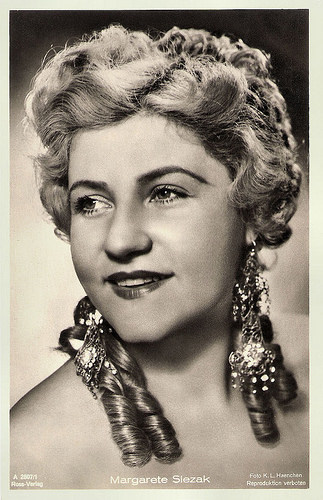
German postcard by Ross Verlag, no. A 2807/1, 1939-1940. Photo: K.L. Haenchen.
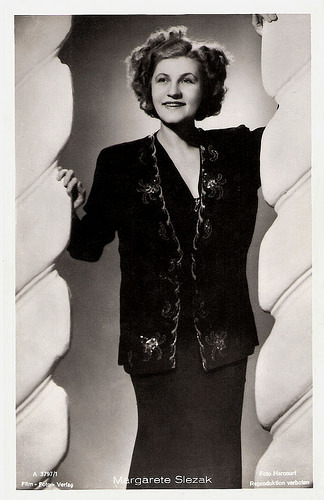
German postcard by Film-Foto-Verlag, no. A 2797/1, 1939-1940. Photo: Harcourt.
Soprano voice
Margarete Slezak was born in 1901 in Breslau (now Wrocław, Poland). She was the daughter of the opera singer and film comedian Leo Slezak and actress Elsa (née Wertheim) Slezak. Her brother was the actor Walter Slezak .
Her father trained her soprano voice and had her learn several instruments such as violin and saxophone. When she was ten years old she sang at the choir of the church in Tegernsee, Bavaria.
Her first engagement took her to the Deutsche Staatsoper Berlin from 1930 to 1933 and soon she became a popular opera singer. From 1935 to 1943 she was a member of the ensemble of the Städtischen Opernhauses Berlin-Charlottenburg.
Slezak also appeared in several films. Her debut was the silent film Das Mädel aus der Hödrichsmühle/The girl from the Hödrich mill (Herr Stumfekl, 1928). Among her sound films are the comedy Ich heirate meine Frau/ I Marry My Wife (Johannes Riemann, 1934) with Lil Dagover , and the crime film Der Vorhang fällt/The Curtain Falls (Georg Jacoby, 1939) starring Anneliese Uhlig .
After the Second World War, Slezak appeared in South America and Southeastern Europe. She also sang in Berlin at the Theater des Westens, at the Staatsoper Berlin and in the Wintergarden.
After her father's death in 1946, she managed the Slezak house in Rottach-Egern, where she lived with her husband, the singer Peter Winter. The book Mein Lebensmärchen (My Life's Fairy Tale), which she published in 1947, is a record of her father's memoirs, which she collected in his last months and published on his behalf after his death.
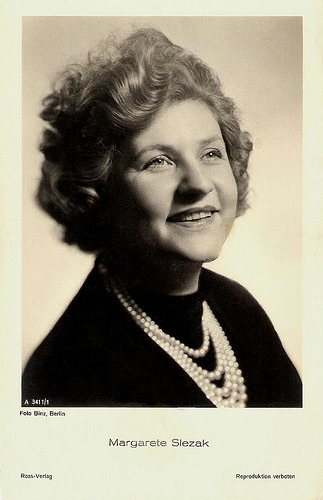
German postcard by Film-Foto-Verlag, no. A 3411/1, 1941-1944. Photo: Tita Binz.
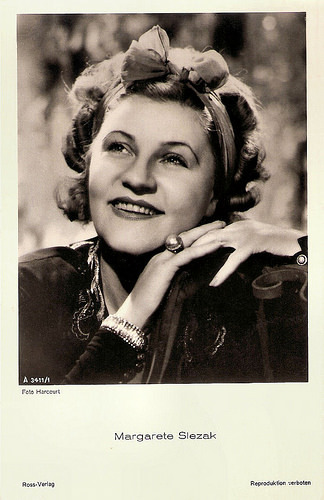
German postcard by Ross Verlag, no. A 3411/1, 1941-1944. Photo: Harcourt.
One of the last Rubble Films
After the war, Margarete Slezak played a supporting role in the West German sports film Derby (Roger von Norman, 1949) starring Hannelore Schroth and Willy Fritsch . With Fritsch, she also appeared in the historical comedy König für eine Nacht/King for One Night (Paul May, 1950).
Then followed a part in the romantic comedy Des Lebens Überfluss/Abundance of Life (Wolfgang Liebeneiner, 1950) one of the last of the Trümmerfilme (Rubble films) made in the immediate post-war years. It updates a story by Ludwig Tieck to modern-day Hamburg, addressing the shortage of housing in the heavily bombed city.
During the 1950s she played supporting parts in operetta films like Die Csardasfürstin/The Csardas Princess (Georg Jacoby, 1950) starring Marika Rökk and Johannes Heesters , and Die Blume von Hawaii/The Flower of Hawaii (Géza von Cziffra, 1953) featuring Maria Litto.
Her final film was the circus film Keine Angst vor großen Tieren/Not Afraid of Big Animals (Ulrich Erfurth, 1953) starring Heinz Rühmann .
Margarete Slezak died in 1953 in Rottach-Egern, West Germany. After her death her biography Der Apfel fällt nicht weit vom Stamm (The apple does not fall far from the tribe) was published.
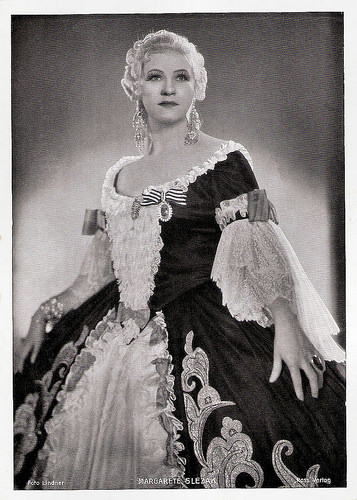
Big German card by Ross Verlag. Photo: Lindner.
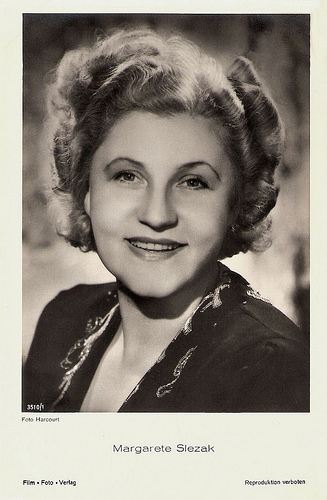
German postcard by Film-Foto-Verlag, no. A 3510/1, 1941-1944. Photo: Harcourt.
Sources: Thomas Staedeli (Cyranos), Filmportal.de, Androom, Wikipedia (German and English), and .

German postcard by Ross Verlag, no. A 2807/1, 1939-1940. Photo: K.L. Haenchen.

German postcard by Film-Foto-Verlag, no. A 2797/1, 1939-1940. Photo: Harcourt.
Soprano voice
Margarete Slezak was born in 1901 in Breslau (now Wrocław, Poland). She was the daughter of the opera singer and film comedian Leo Slezak and actress Elsa (née Wertheim) Slezak. Her brother was the actor Walter Slezak .
Her father trained her soprano voice and had her learn several instruments such as violin and saxophone. When she was ten years old she sang at the choir of the church in Tegernsee, Bavaria.
Her first engagement took her to the Deutsche Staatsoper Berlin from 1930 to 1933 and soon she became a popular opera singer. From 1935 to 1943 she was a member of the ensemble of the Städtischen Opernhauses Berlin-Charlottenburg.
Slezak also appeared in several films. Her debut was the silent film Das Mädel aus der Hödrichsmühle/The girl from the Hödrich mill (Herr Stumfekl, 1928). Among her sound films are the comedy Ich heirate meine Frau/ I Marry My Wife (Johannes Riemann, 1934) with Lil Dagover , and the crime film Der Vorhang fällt/The Curtain Falls (Georg Jacoby, 1939) starring Anneliese Uhlig .
After the Second World War, Slezak appeared in South America and Southeastern Europe. She also sang in Berlin at the Theater des Westens, at the Staatsoper Berlin and in the Wintergarden.
After her father's death in 1946, she managed the Slezak house in Rottach-Egern, where she lived with her husband, the singer Peter Winter. The book Mein Lebensmärchen (My Life's Fairy Tale), which she published in 1947, is a record of her father's memoirs, which she collected in his last months and published on his behalf after his death.

German postcard by Film-Foto-Verlag, no. A 3411/1, 1941-1944. Photo: Tita Binz.

German postcard by Ross Verlag, no. A 3411/1, 1941-1944. Photo: Harcourt.
One of the last Rubble Films
After the war, Margarete Slezak played a supporting role in the West German sports film Derby (Roger von Norman, 1949) starring Hannelore Schroth and Willy Fritsch . With Fritsch, she also appeared in the historical comedy König für eine Nacht/King for One Night (Paul May, 1950).
Then followed a part in the romantic comedy Des Lebens Überfluss/Abundance of Life (Wolfgang Liebeneiner, 1950) one of the last of the Trümmerfilme (Rubble films) made in the immediate post-war years. It updates a story by Ludwig Tieck to modern-day Hamburg, addressing the shortage of housing in the heavily bombed city.
During the 1950s she played supporting parts in operetta films like Die Csardasfürstin/The Csardas Princess (Georg Jacoby, 1950) starring Marika Rökk and Johannes Heesters , and Die Blume von Hawaii/The Flower of Hawaii (Géza von Cziffra, 1953) featuring Maria Litto.
Her final film was the circus film Keine Angst vor großen Tieren/Not Afraid of Big Animals (Ulrich Erfurth, 1953) starring Heinz Rühmann .
Margarete Slezak died in 1953 in Rottach-Egern, West Germany. After her death her biography Der Apfel fällt nicht weit vom Stamm (The apple does not fall far from the tribe) was published.

Big German card by Ross Verlag. Photo: Lindner.

German postcard by Film-Foto-Verlag, no. A 3510/1, 1941-1944. Photo: Harcourt.
Sources: Thomas Staedeli (Cyranos), Filmportal.de, Androom, Wikipedia (German and English), and .
Published on April 22, 2018 22:00
Paul van Yperen's Blog
- Paul van Yperen's profile
- 13 followers
Paul van Yperen isn't a Goodreads Author
(yet),
but they
do have a blog,
so here are some recent posts imported from
their feed.



